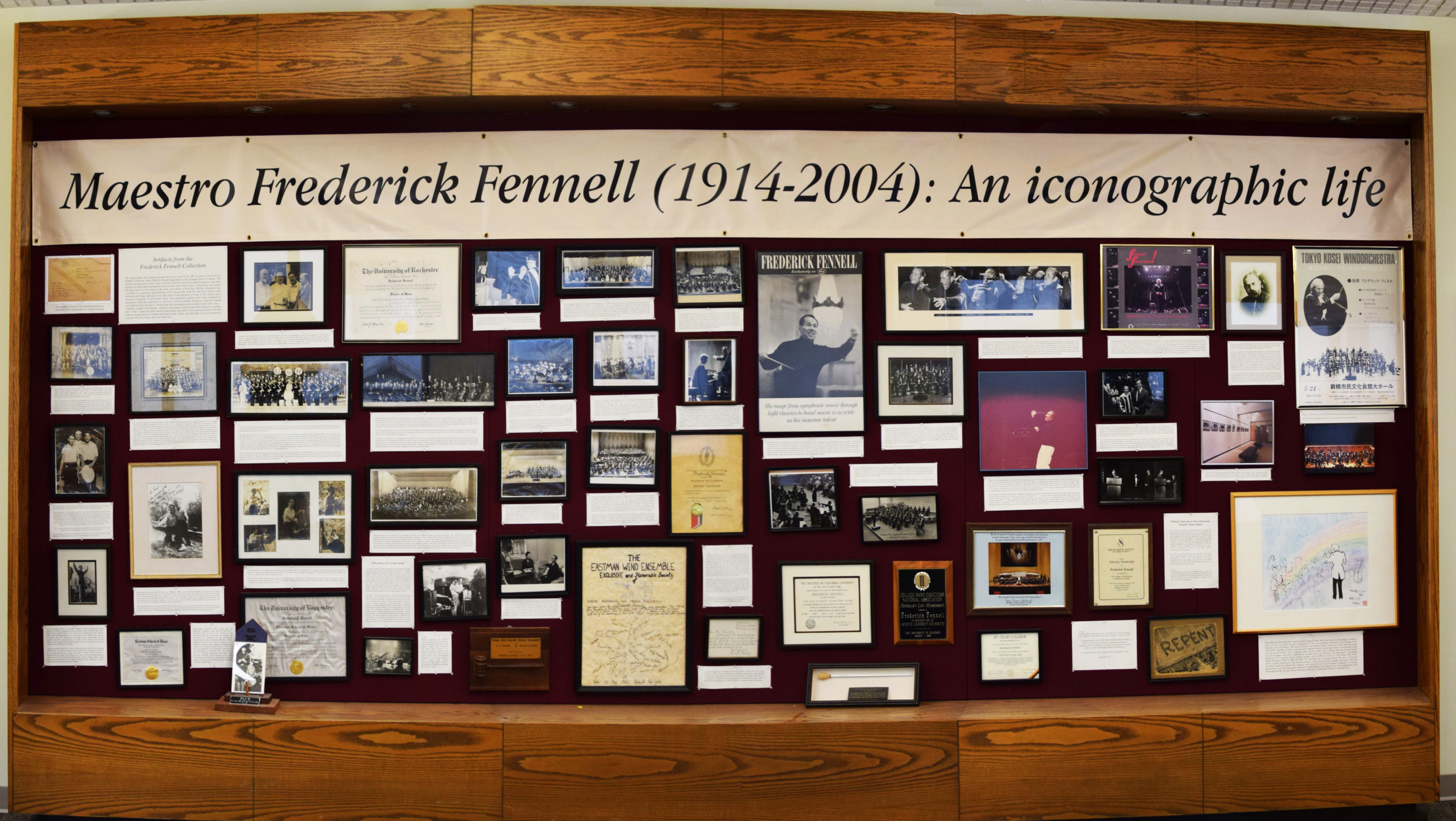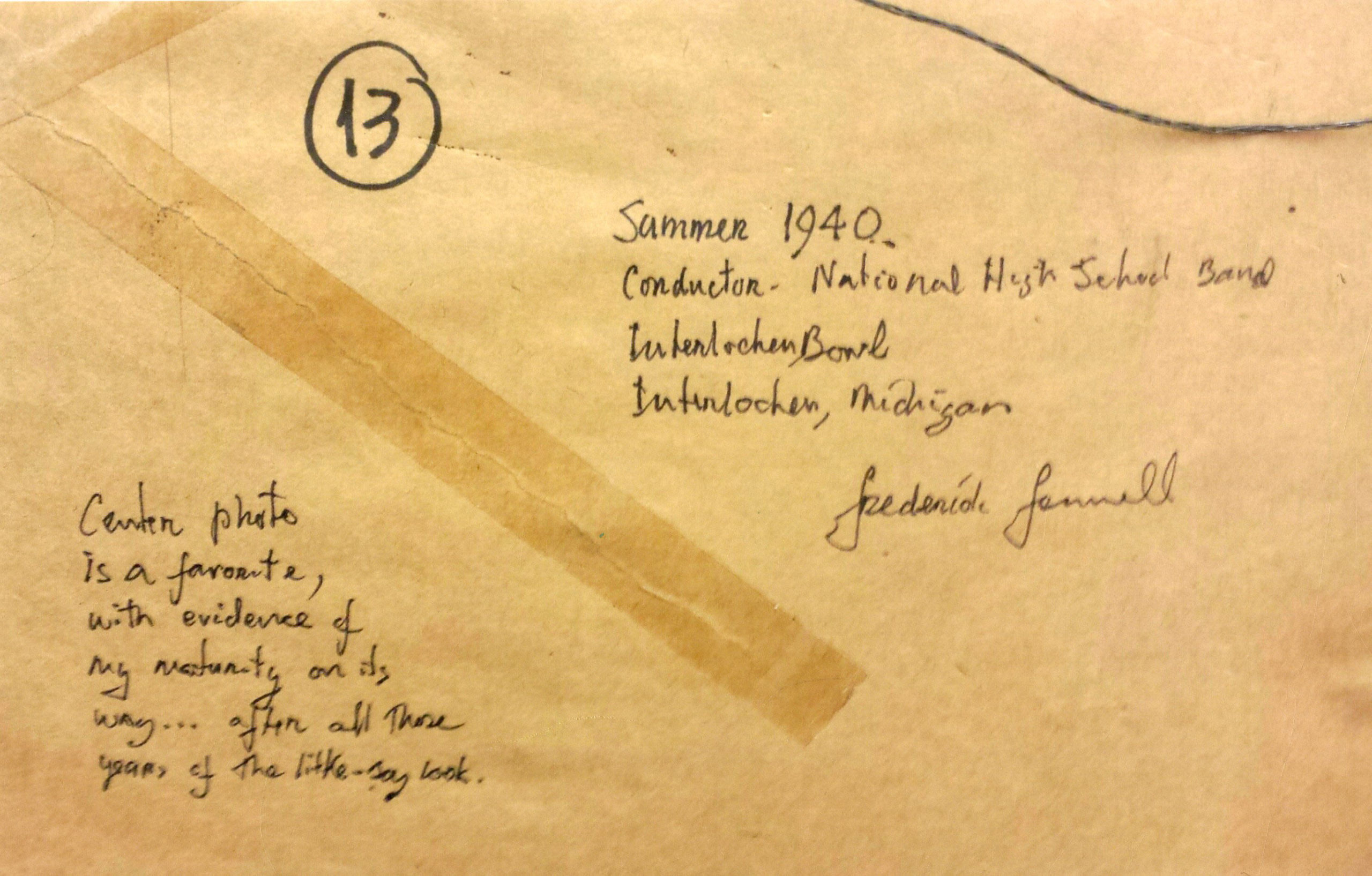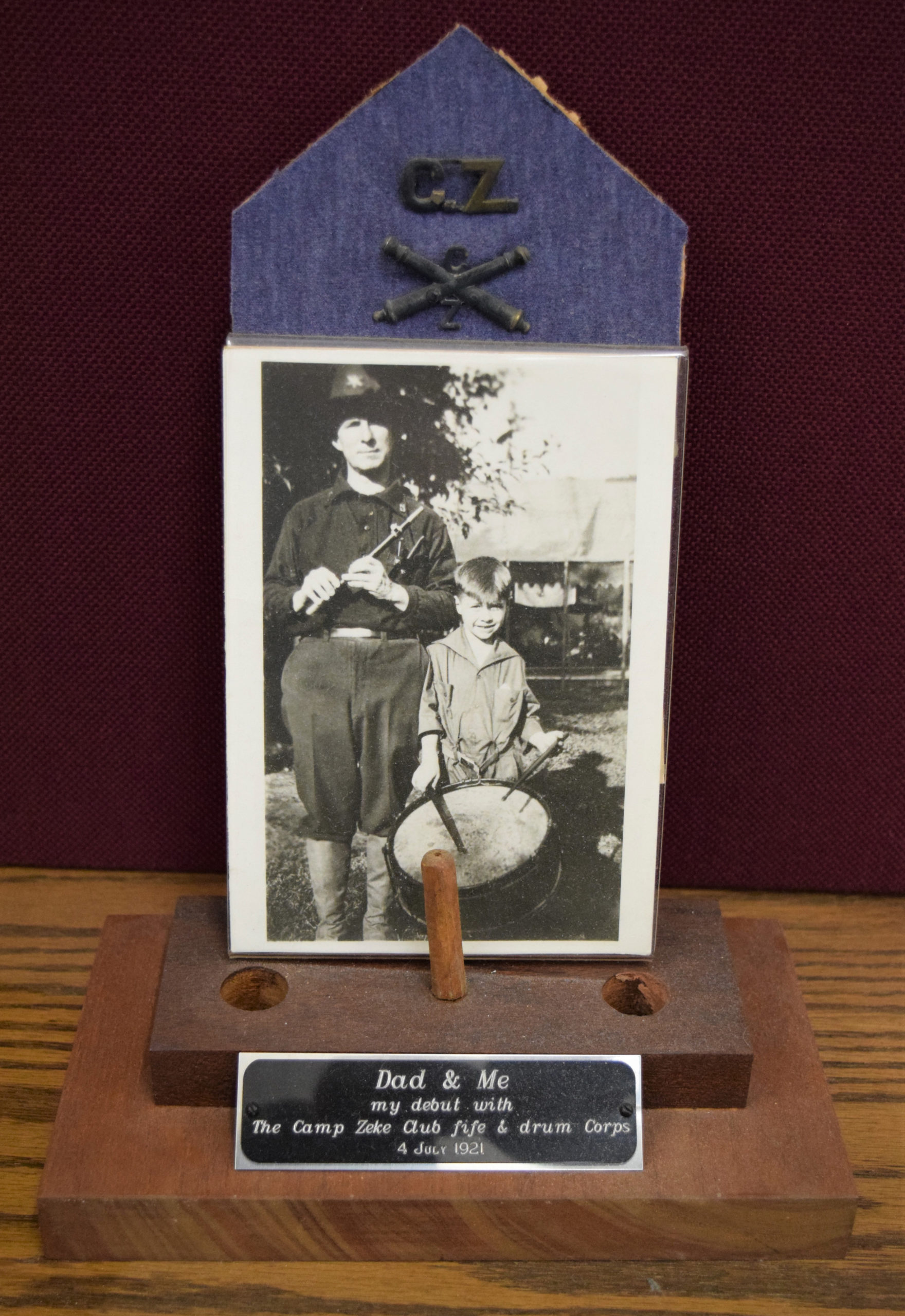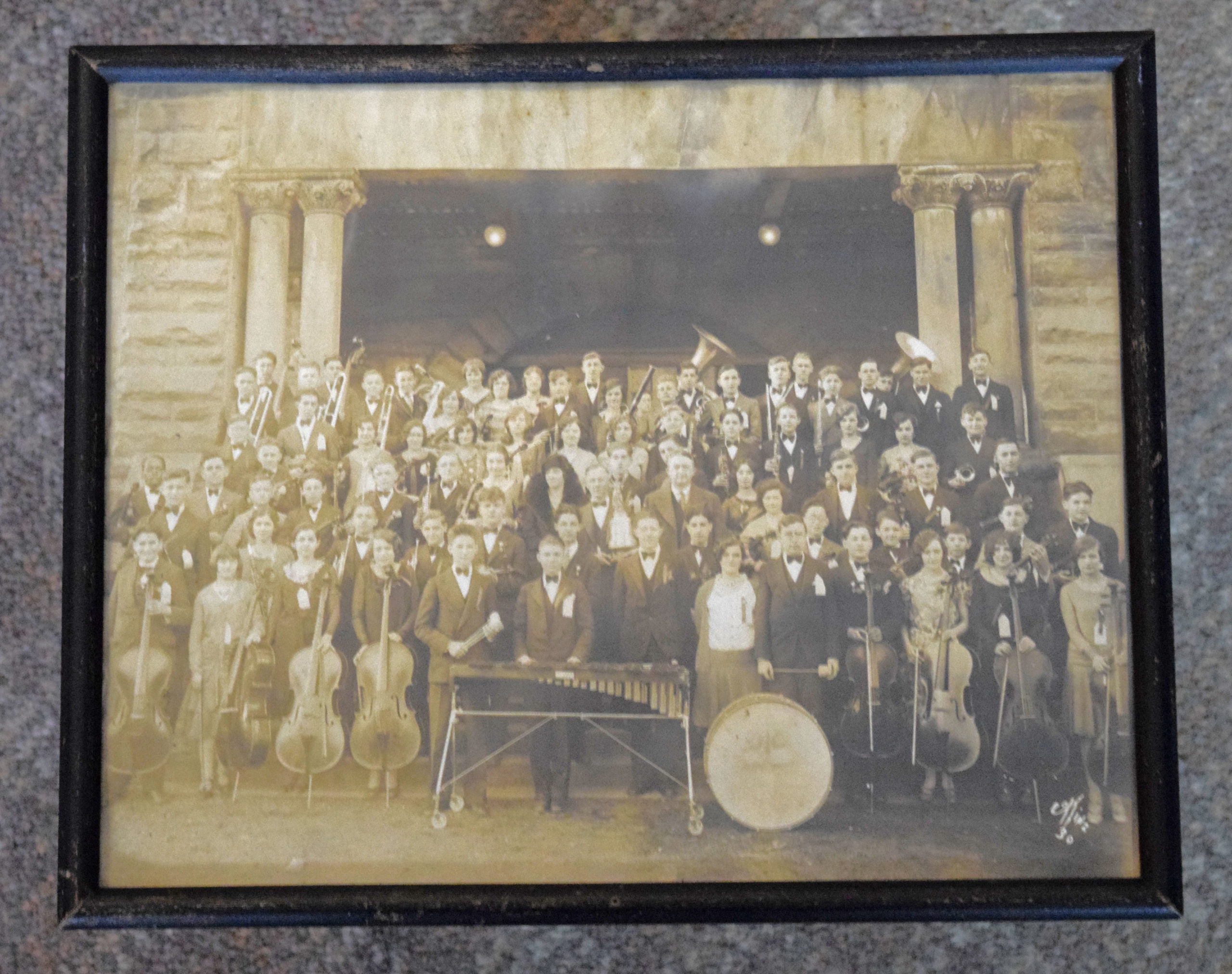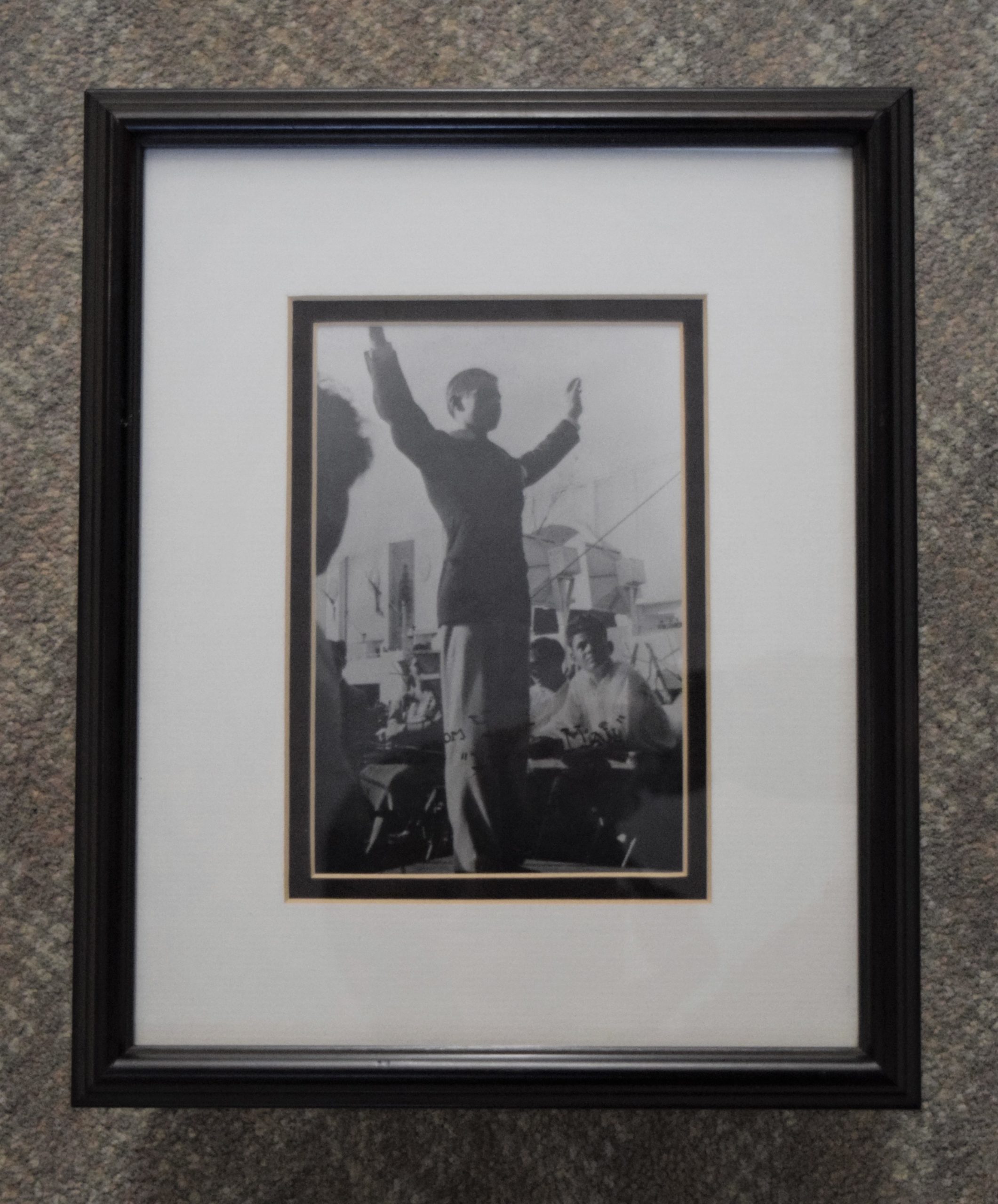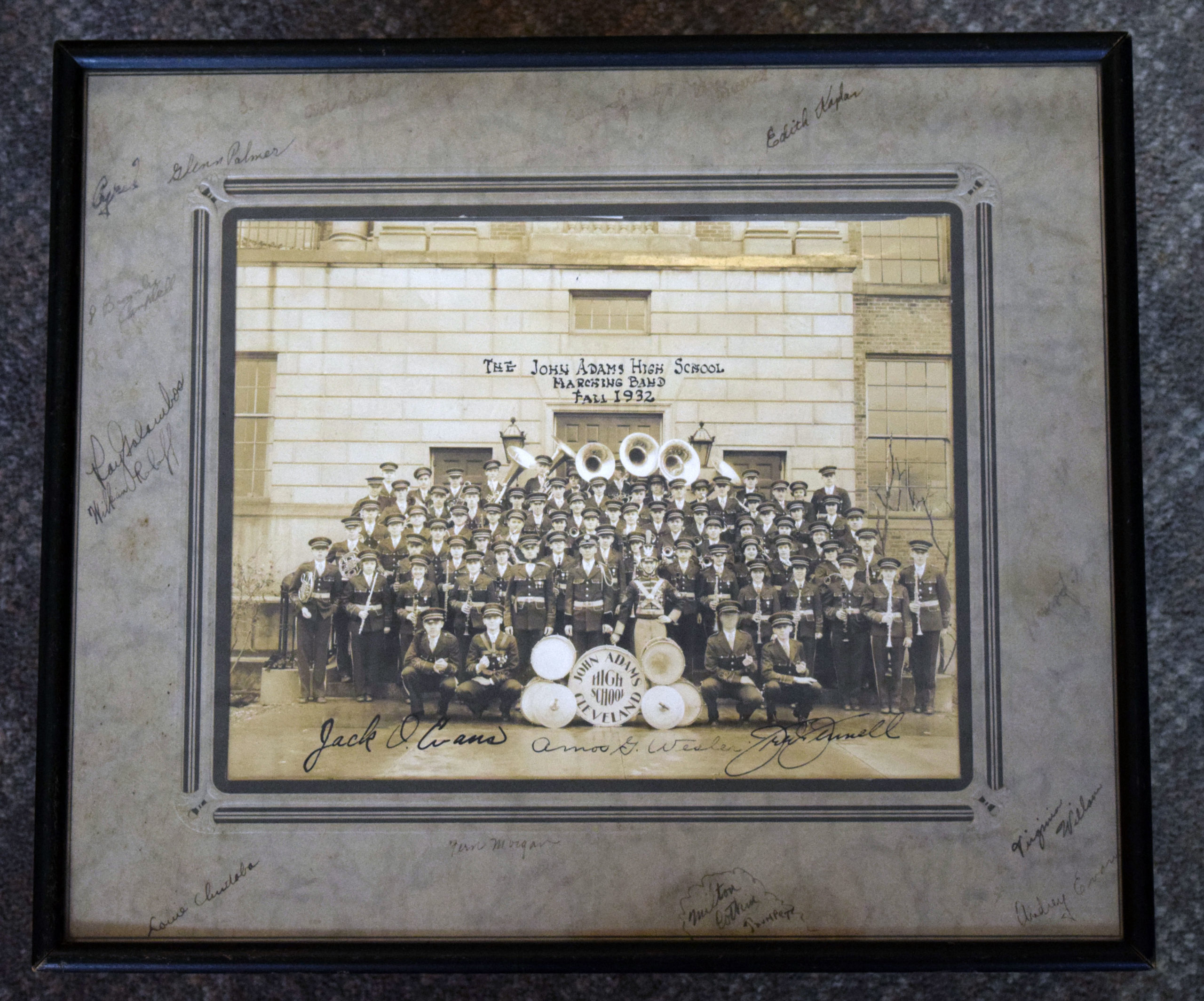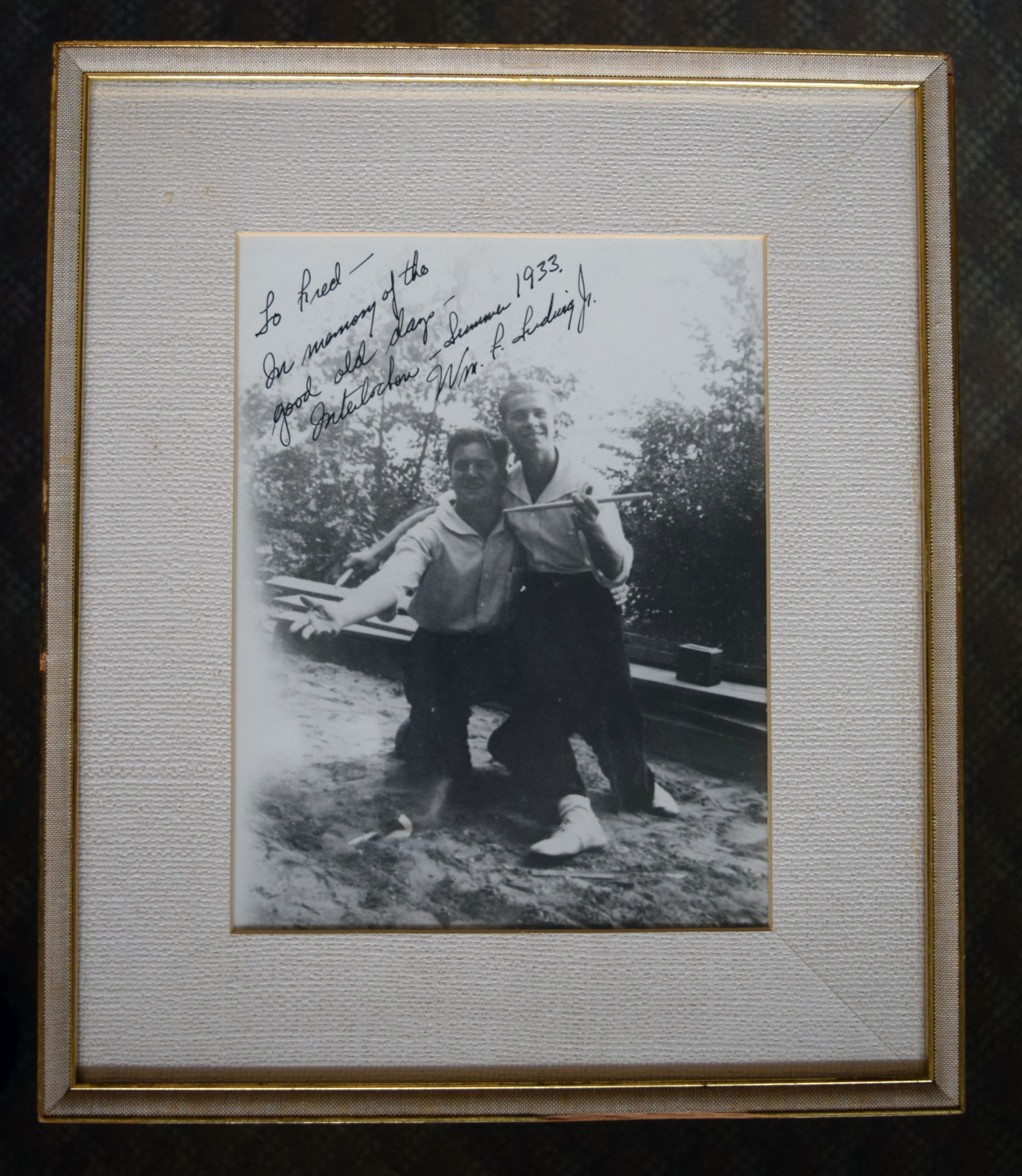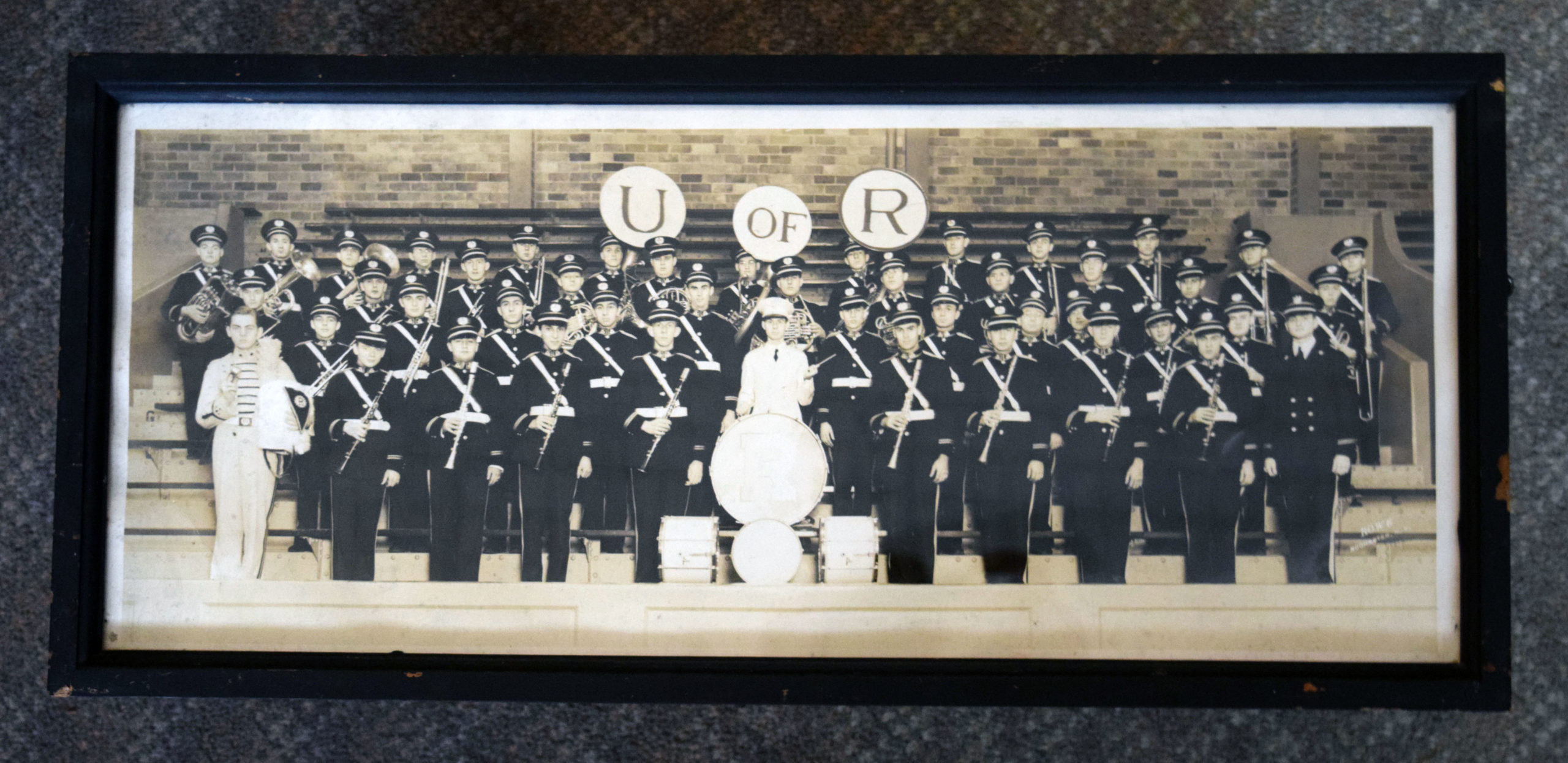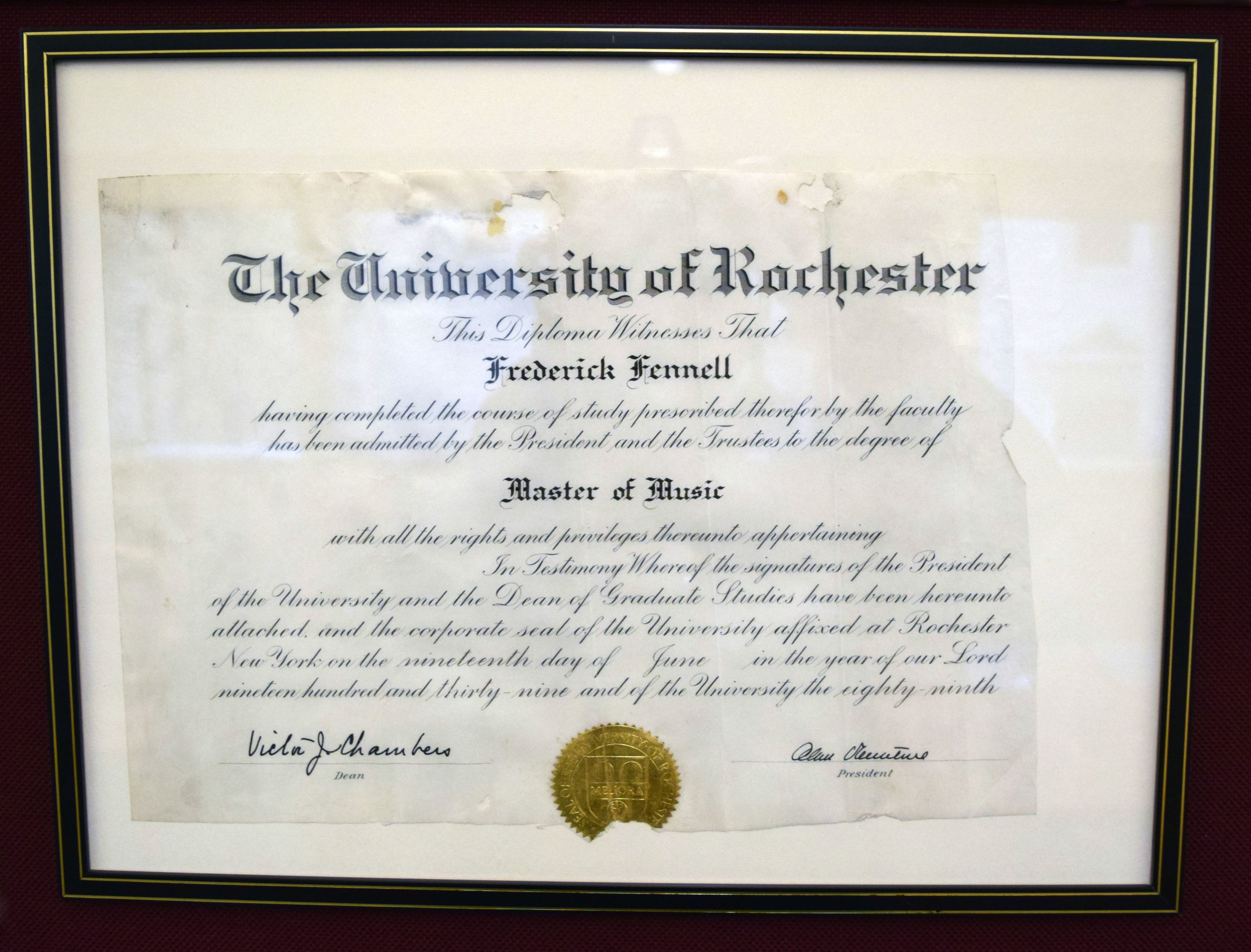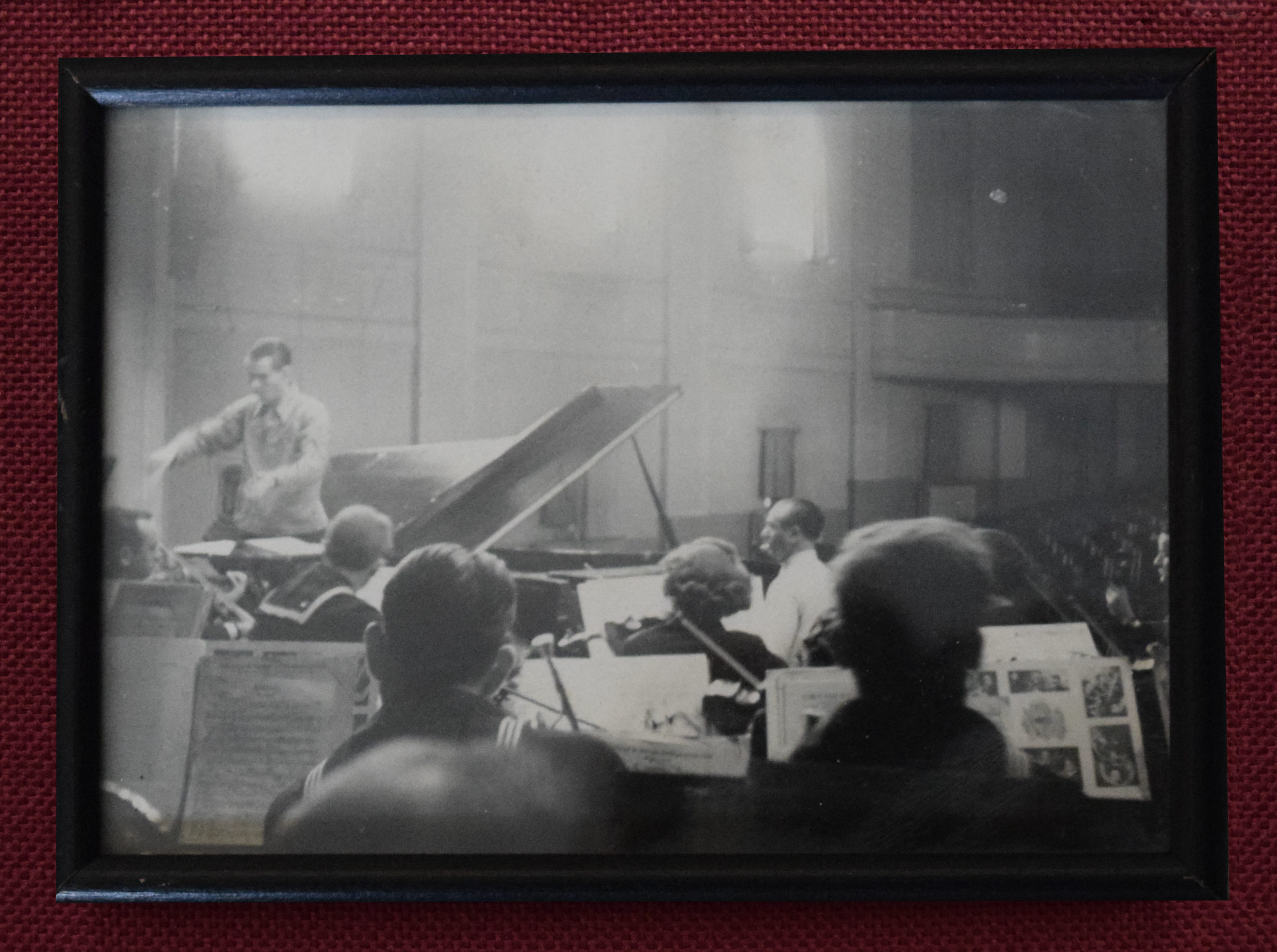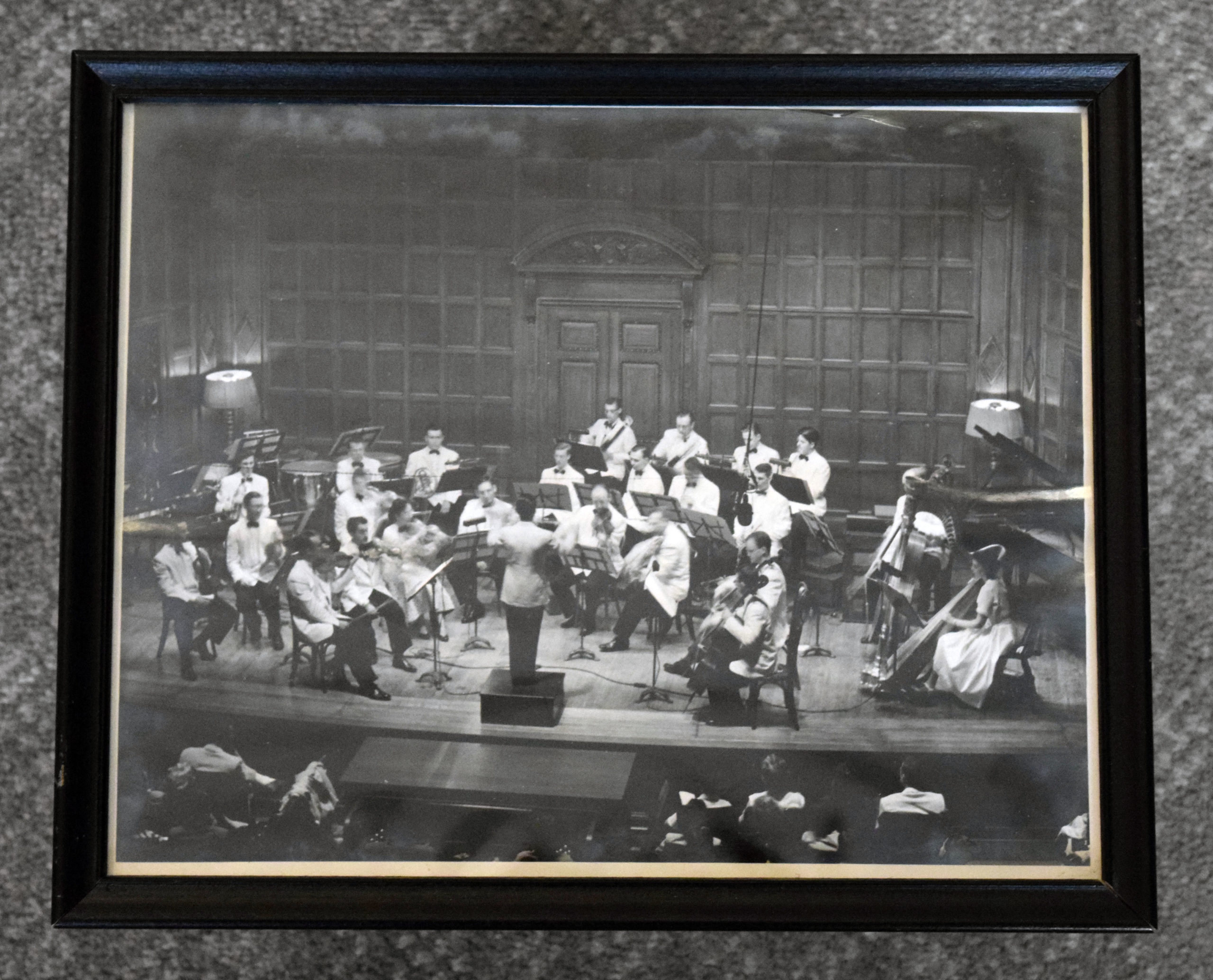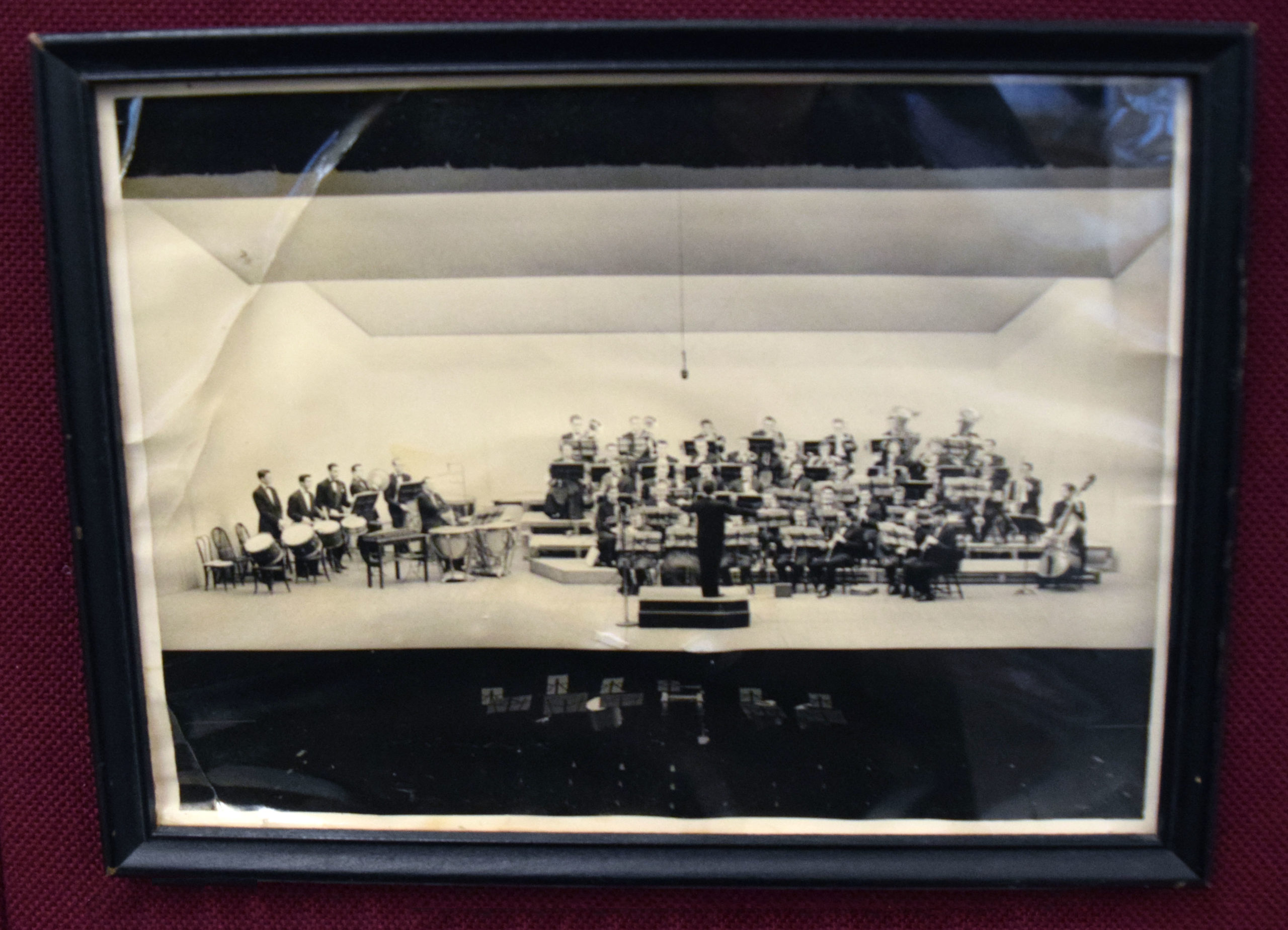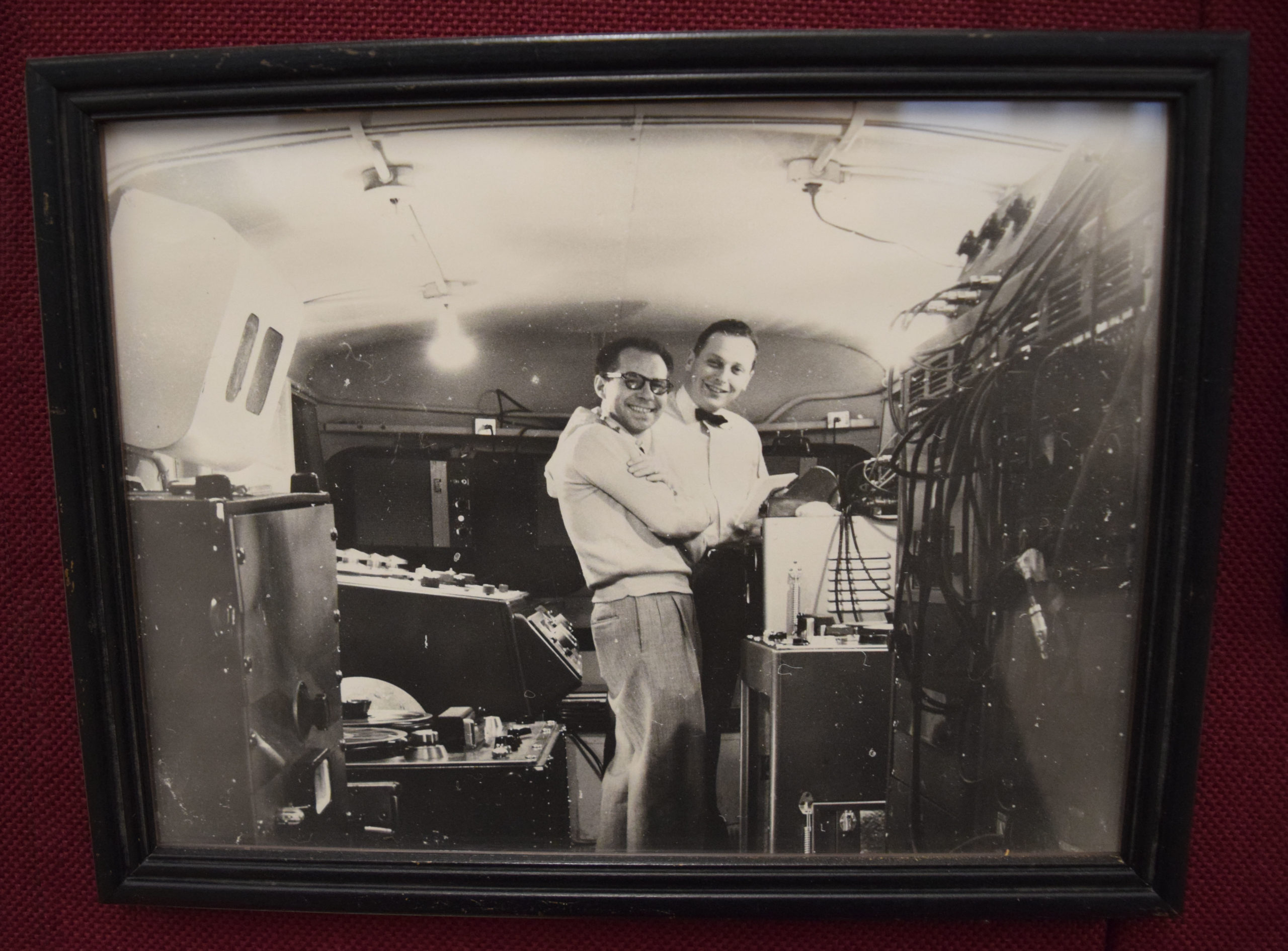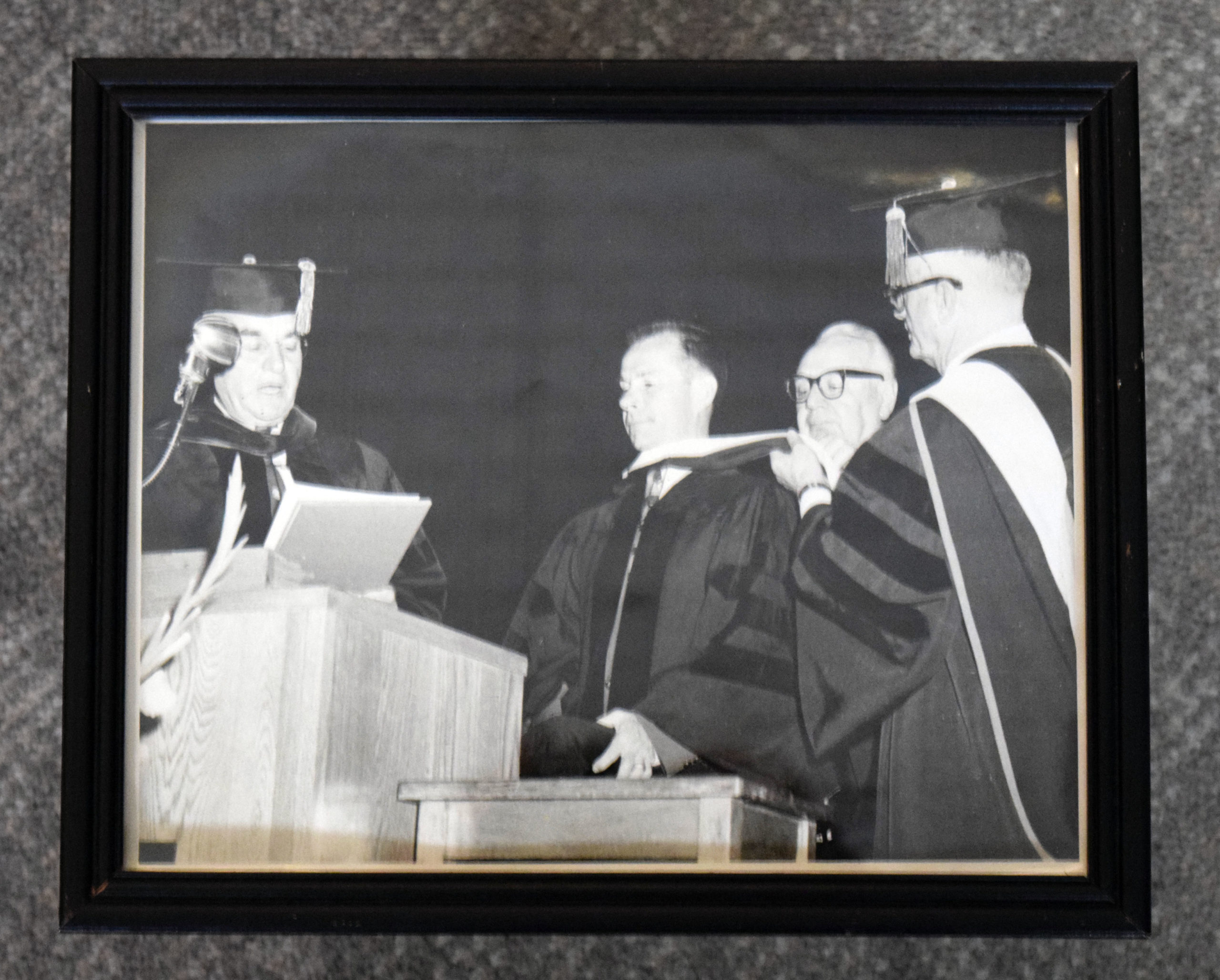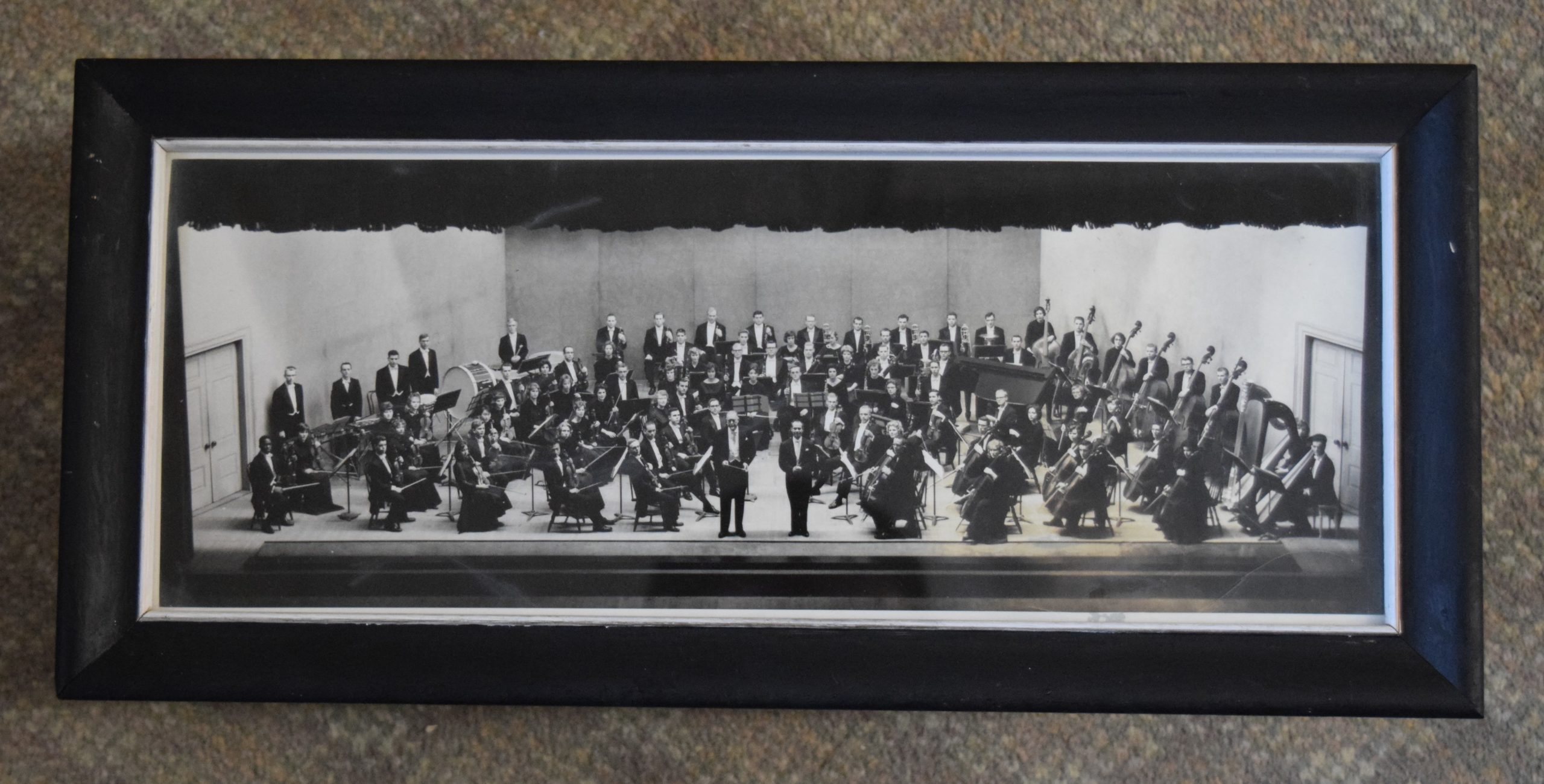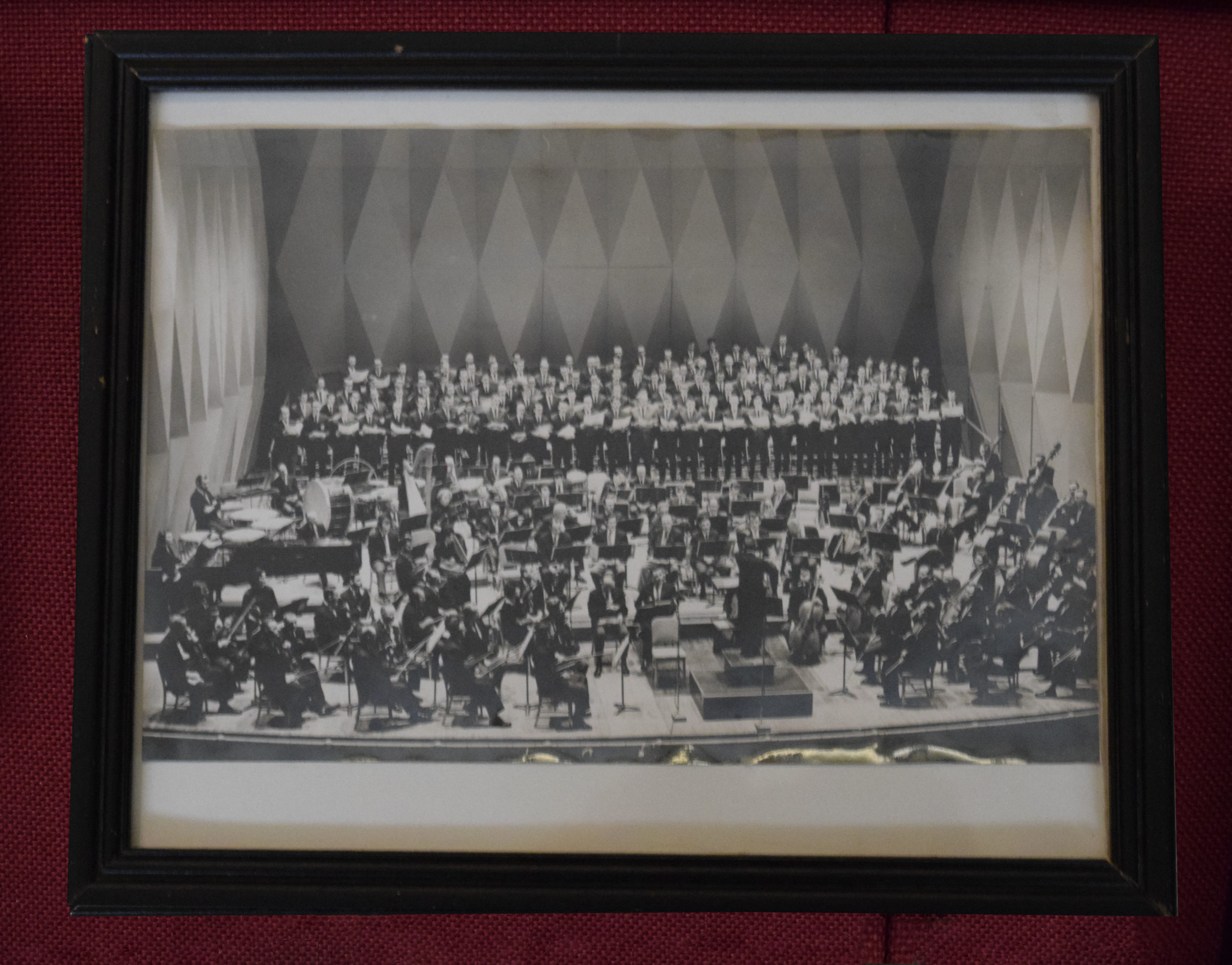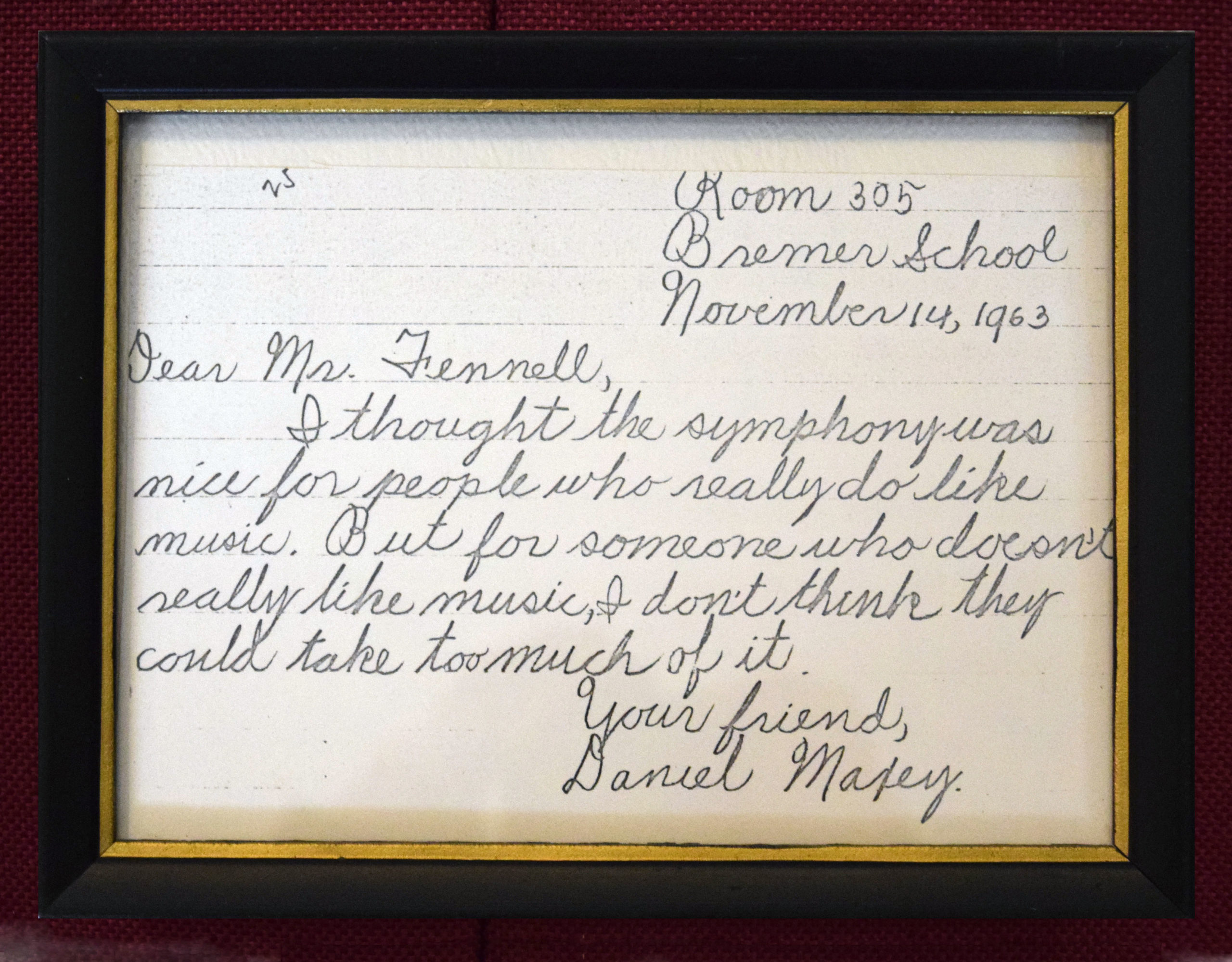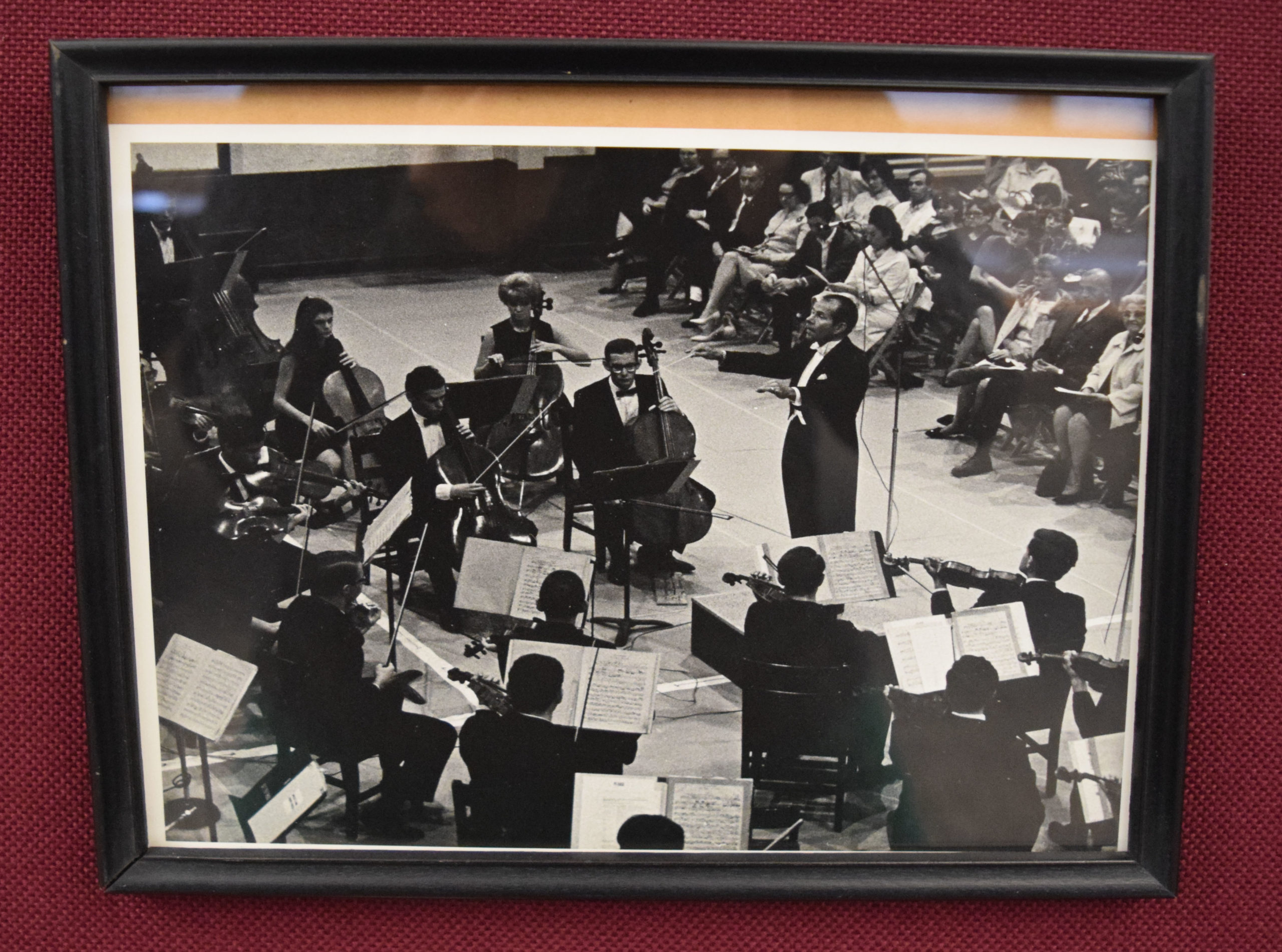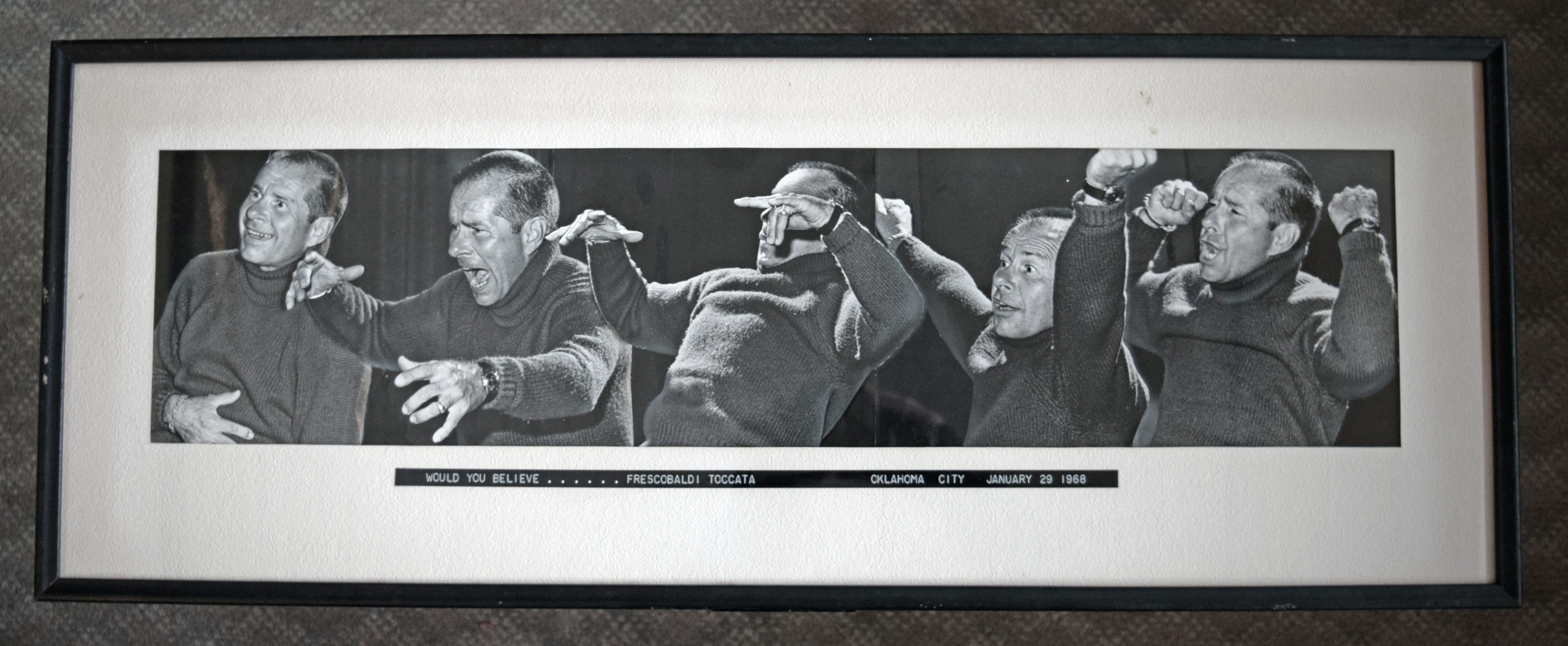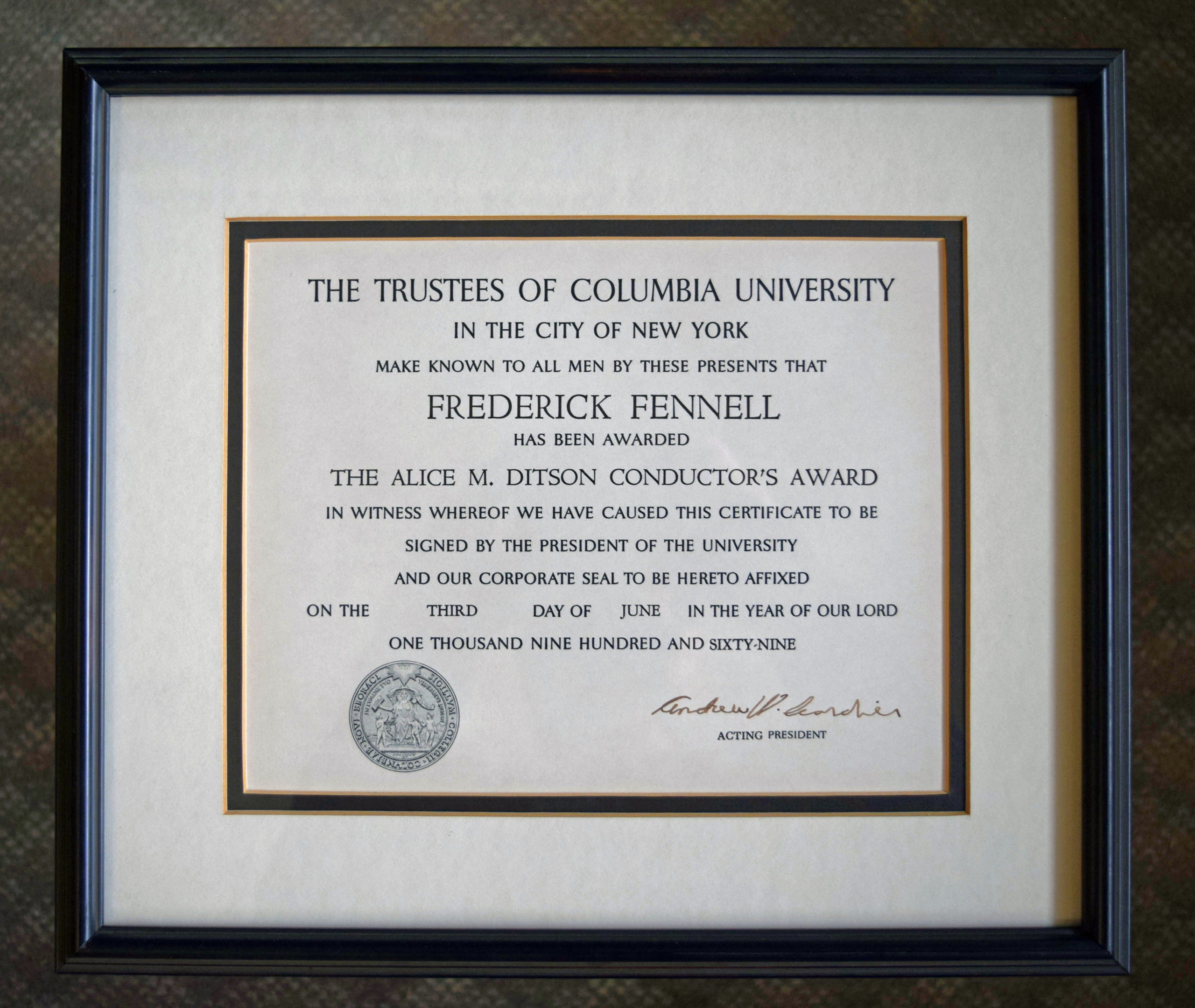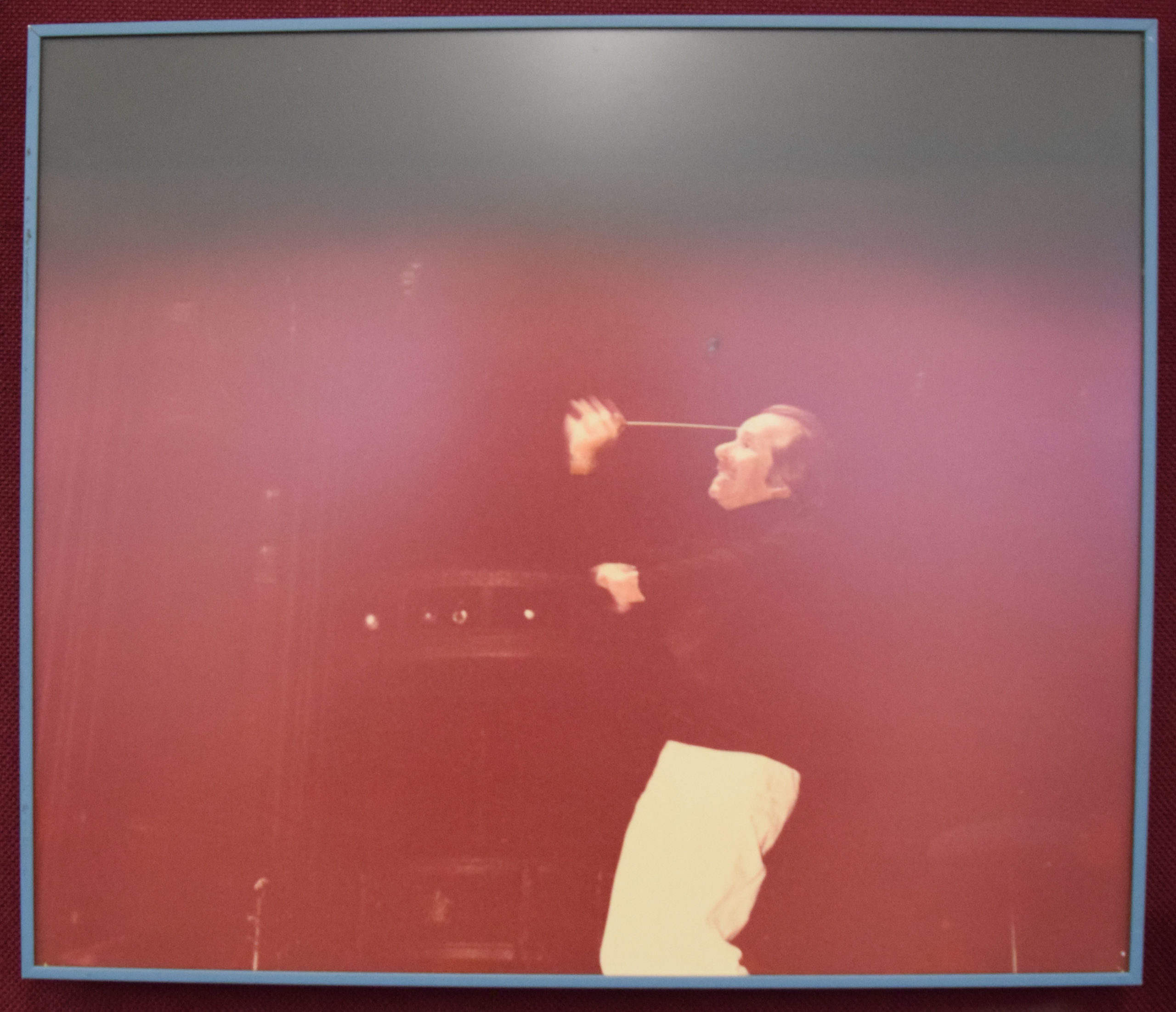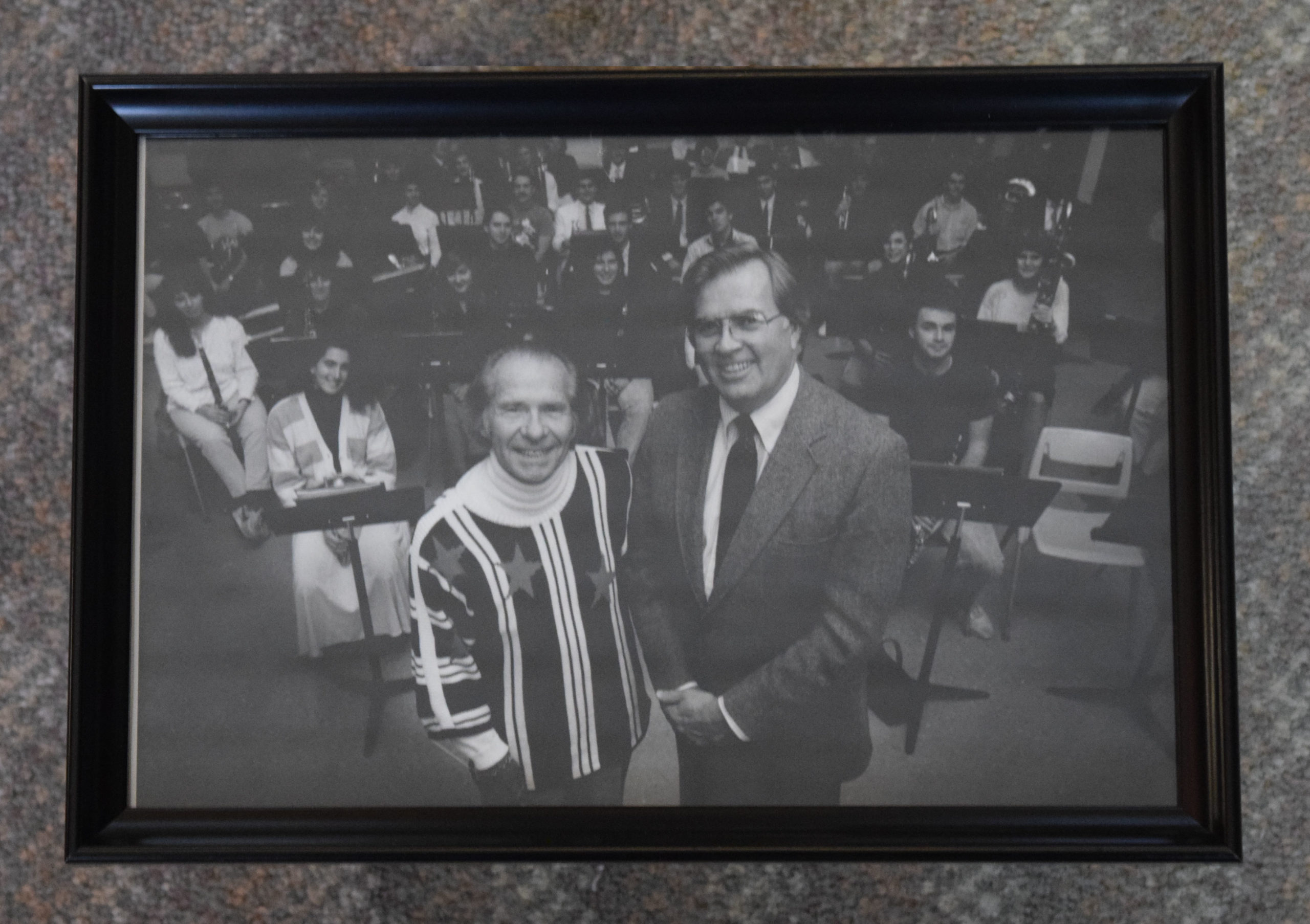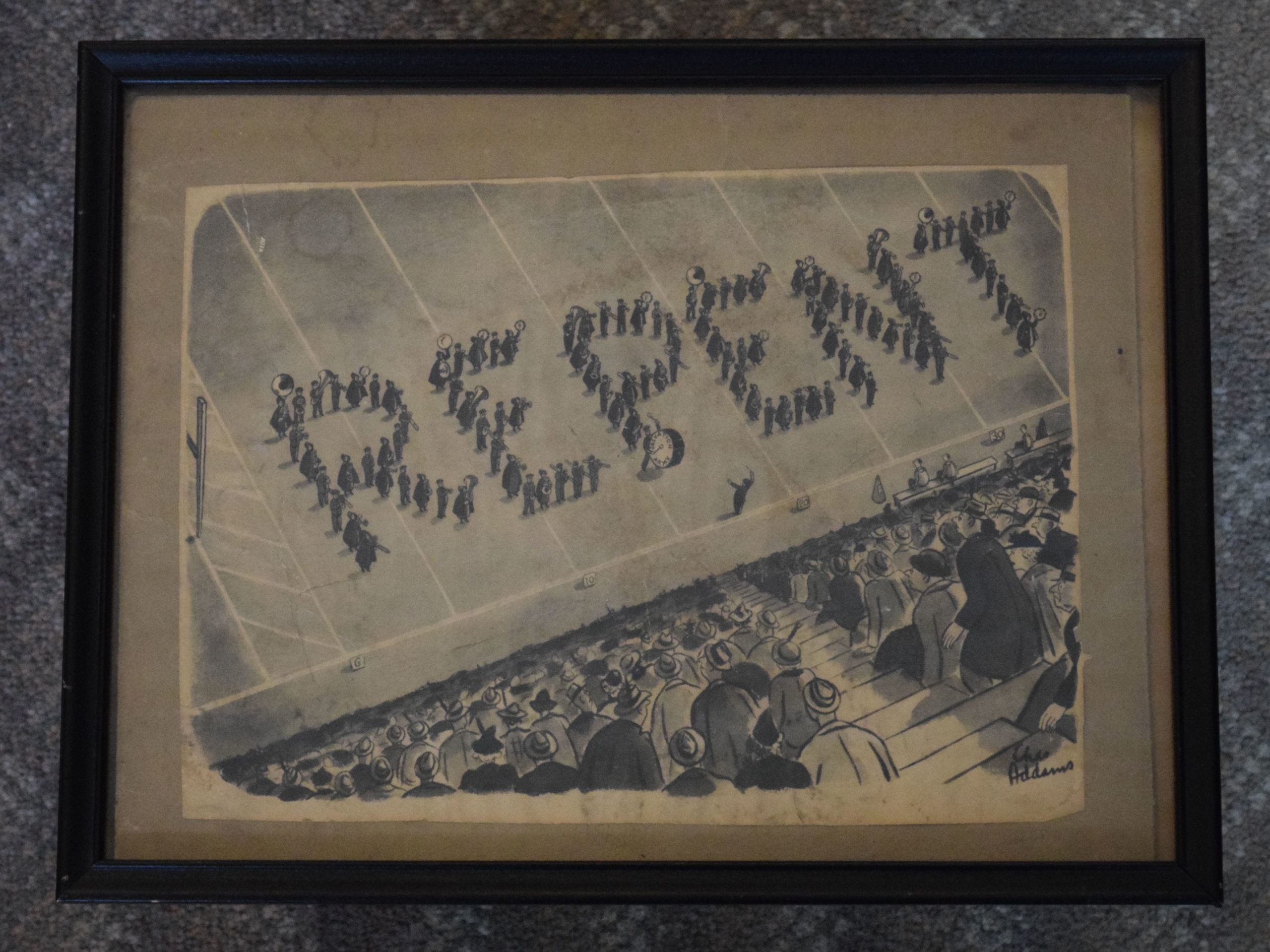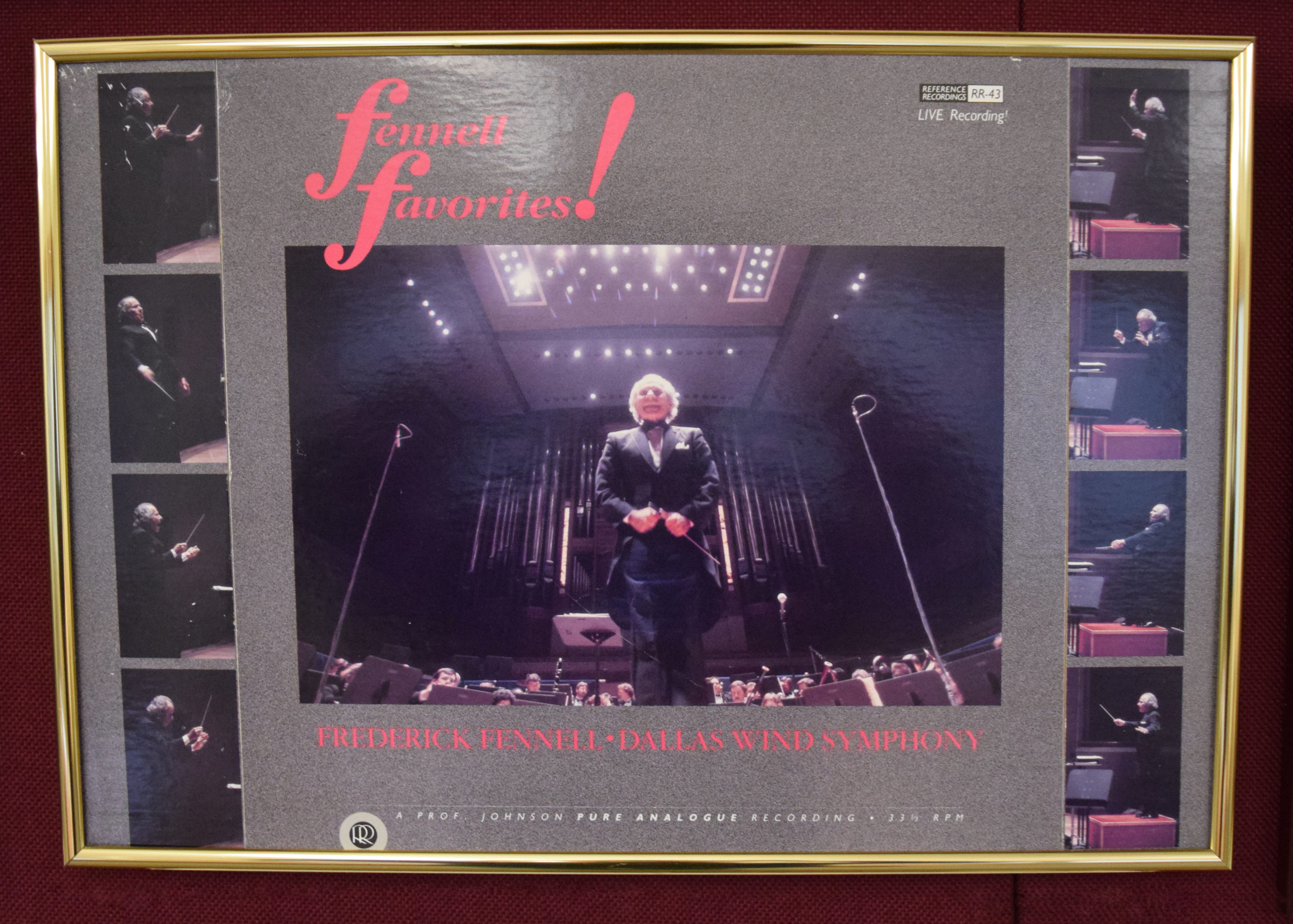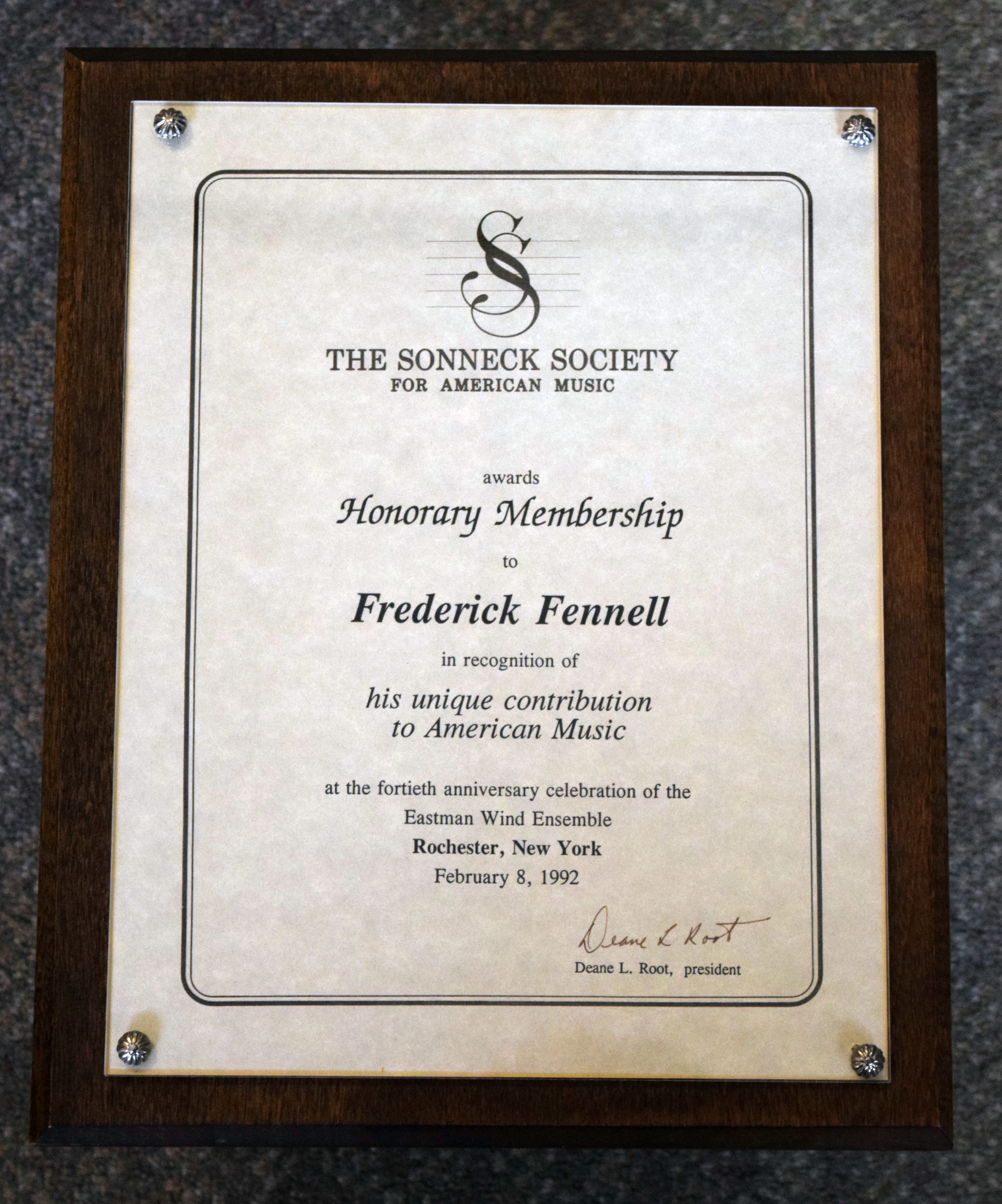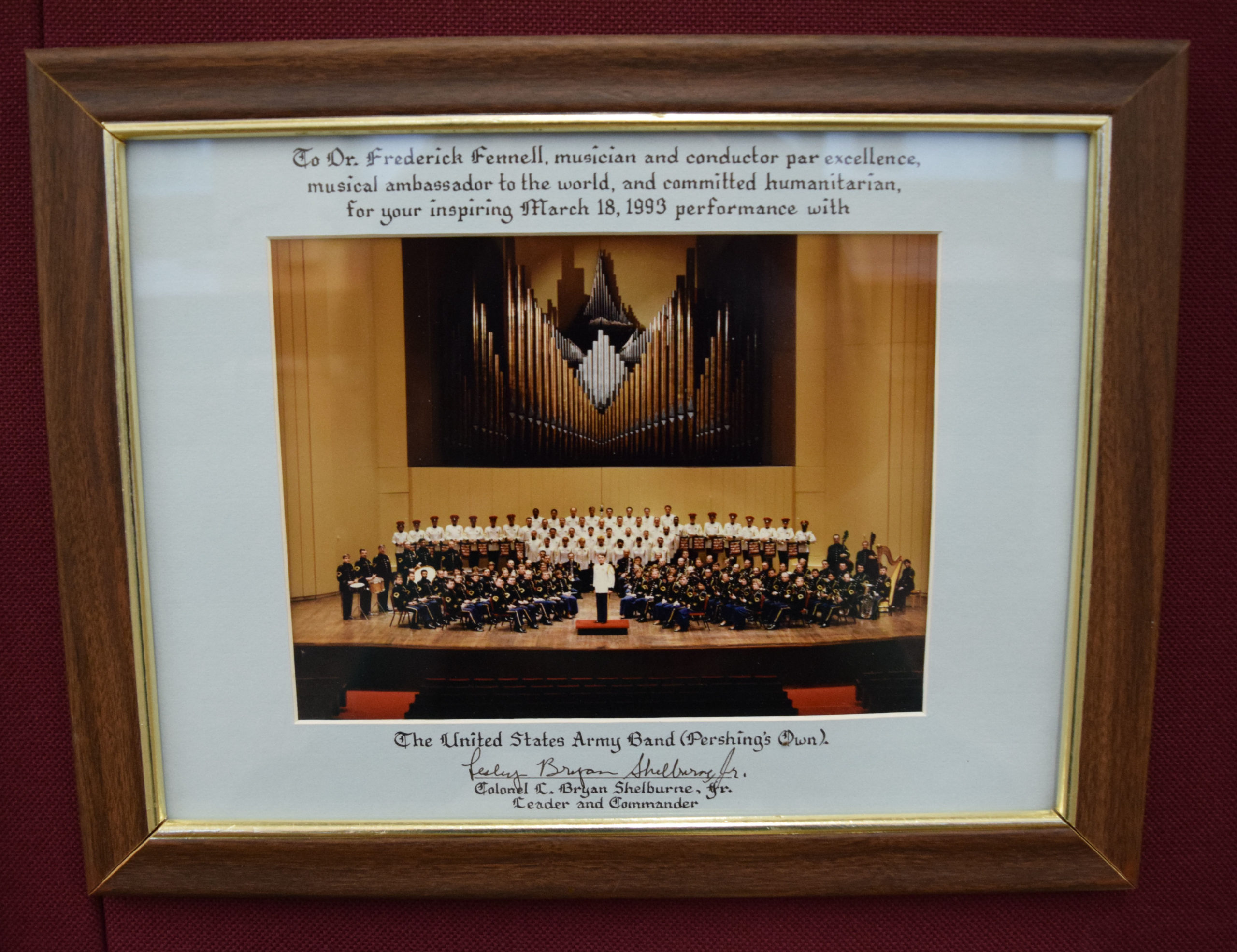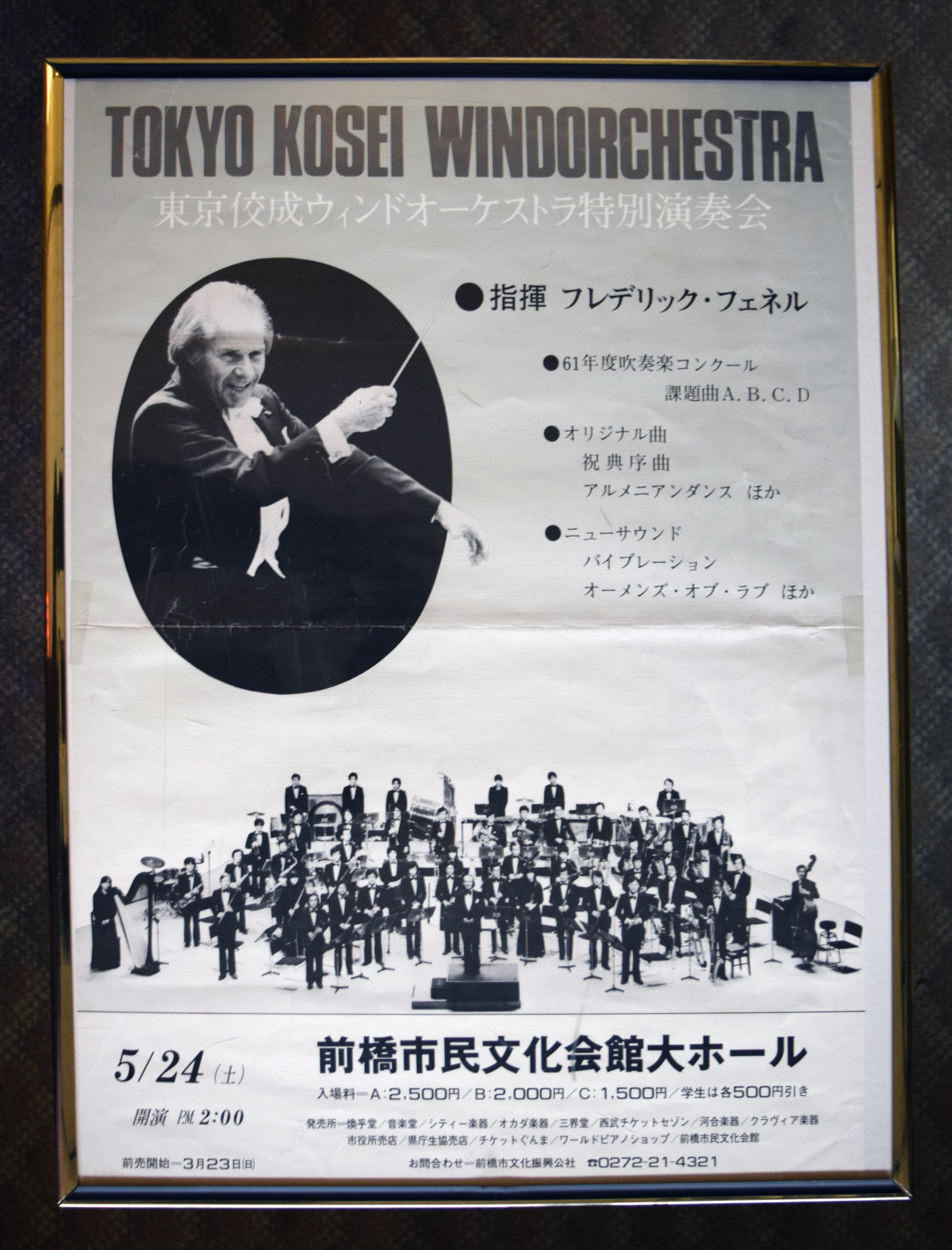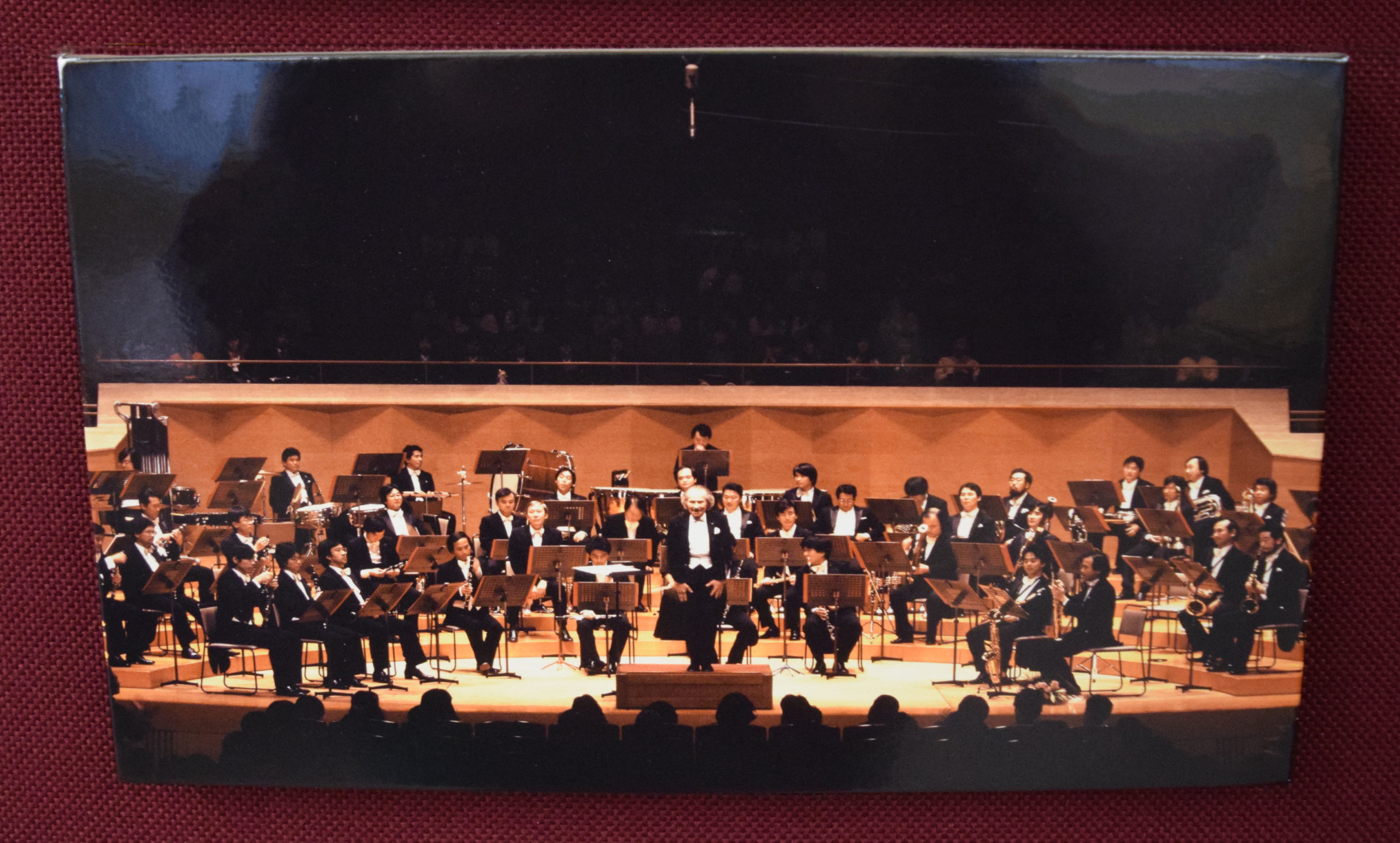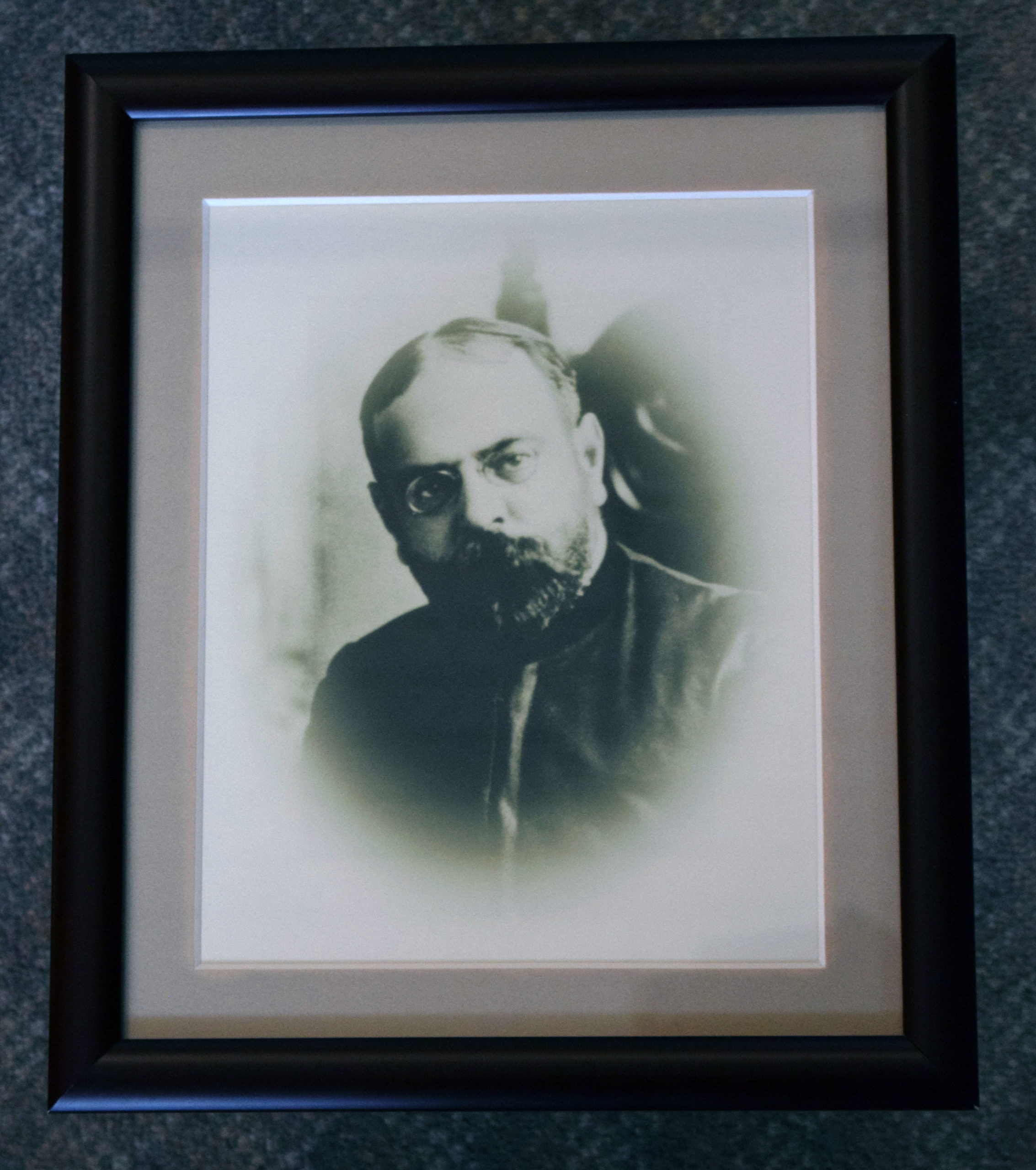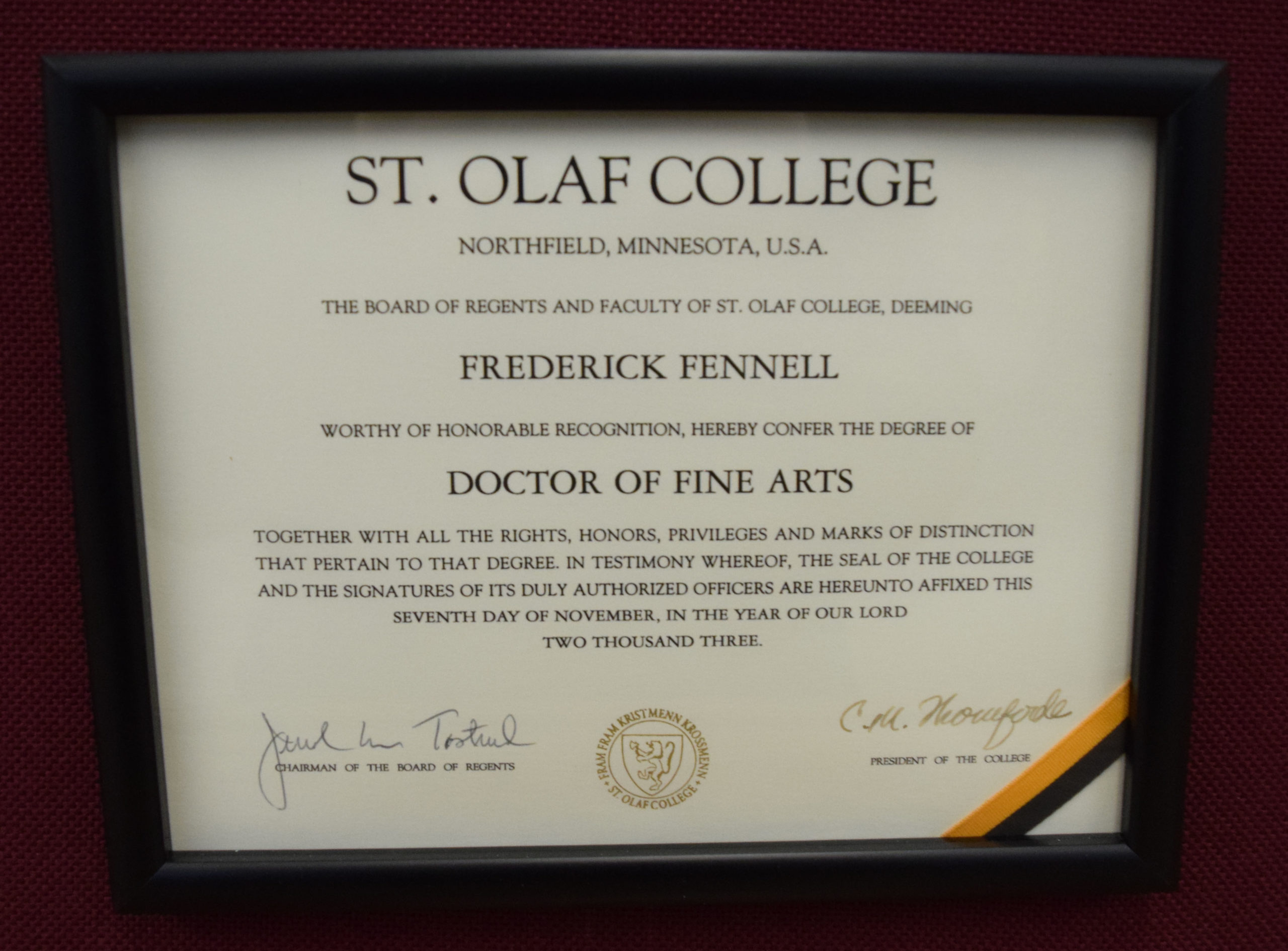Exhibit displayed in the Eastman Wind Ensemble Room on the 4th floor of Sibley Music Library, October 2014–January 2023; curated by David Peter Coppen
The photographs and awards presented here were received in 2005 as part of the Frederick Fennell Collection, which Maestro Fennell bequeathed to the Eastman School of Music. The artifacts are presented as they were received, framed by Fennell or under his agency, and many bearing his handwritten annotations on the reverse sides of the frames. These items were among the many known to have hung on the walls of his home in Siesta Key, Florida. Altogether they contribute to a panoramic representation of his musical life, from fife and drum corps in early boyhood and drum majoring in his late teens to the direction of some of the world’s most renowned ensembles in his mature years. The descriptive captions have been informed by documents within the collection, as well as by sources available elsewhere. Frederick Fennell was multi-faceted, innovative, enterprising, the consummate professional in each of his roles—conductor, teacher and clinician, composer and arranger, percussionist and tympanist, recording artist, writer, widely travelled musical ambassador, and patriot, who touched listeners and who influenced generations of students and professionals. These, and still more: he was an American original who never forgot where he came from.
On Display
John Adams High School Orchestra (1932)
The members of the John Adams High School Orchestra (Cleveland, Ohio) pose on the steps of Finney Chapel at Oberlin College in May, 1930 after winning a state-wide contest. The orchestra conductor was Mr. Amos G. Wesler, who also conducted the school band; he stands with baton in the front row, fifth from the right. The young Fred Fennell, percussionist, stands in the front row at center.
Born in Cleveland, the young Fennell attended John Adams High School, est. 1923, situated at the corner of East 116th Street and Corlett Avenue in Cleveland. There he quickly established himself as an engaged and dynamic young man who was well-liked by his peers and who was headed for leadership. He belonged to various clubs, served as president of the student council and as president of his homeroom, and eventually, was elected by his class to be one of the five student speakers at his class graduation (1933).
Fennell with Bill Ludwig and Mr. Ludwig (1932)
The young Fennell with his friend Bill Ludwig and Mr. Ludwig (Bill’s father), taken at the National Music Camp. As Fennell wrote on the reverse side of the frame:
“Photo early August 1932, taken with us standing at the head of set of wooden stairs that led down to the beach, late on a Sunday afternoon (white shirts) Bill’s dad had come up for the week-end to see and hear Bill play and to bring him a gift of one of the very first super sensitive snare drums off the production line. The scene is behind the bowl. Camp is in its 5th summer and Bill Ludwig and I had risen to an endless, a fantastic friendship – – life-long. Bill was 16, I was 18 – – a great father & son photo. I still wear my belt buckle at the left side. The drumsticks I hold were a gift from Jack Bryden, the principal percussionist in 1931, who became a world-recognized musicologist, Dean at Transylvania (University in Lexington, Kentucky), and a very good conductor.
“This is – one-of-a-kind photo blown up from a Brownie film, that I think was taken by Jane Austin Harding, the conductor’s daughter who was a camper that Bill had it for.”
Young Fennell and young Ludwig had just met for the first time that summer. They became fast friends, and would remain close throughout their long lives.
Fennell’s conducting debut (1933)
This photograph captures a milestone moment. Fennell is making his public debut as a conductor, appearing as guest conductor of the National High School Band of the National Music Camp. This concert appearance by the National High School Band took place in the Hall of States at the World’s Fair, Chicago, on August 20th, 1933. During the Interlochen summer session that year, the campers spent the session’s final two weeks at the World’s Fair with all expenses paid. During their Chicago sojourn they also performed in the Music Administration Building in Evanston.
On this occasion Fennell was invited to the podium by Albert Austin Harding (1880-1958), who was the National High School Band’s permanent conductor. A. A. Harding served for 41 years as Director of Bands of the University of Illinois; during his tenure John Philip Sousa went on record praising Harding’s concert band at the University of Illinois as the world’s greatest college concert band. The young Fennell would remain in contact with Mr. Harding for years to come following his summers at Interlochen.
John Adams High School Marching Band (1932)
The assembled members of the marching band of John Adams High School, photographed in uniform in the fall of 1932, when Fennell was in his senior year. He stands in the front row at center. (The signatures were apparently added during a reunion event some time later.)
Fennell was drum major of the marching band in his senior year, but attaining that rank had not been a foregone conclusion. For one thing, he stood only 5’ 1” tall (!) at the time, but he had nevertheless demonstrated keen initiative in seeking out relevant training. An interest in conducting had been stimulated during his first summer at the National Music Camp at Interlochen, Michigan (1931), when he had been one of some 50 boys receiving instruction in baton technique from Russian-born conductor Vladimir Bakaleinikov (1885-1953). While attending Interlochen the following summer, he was the only high school camper to be admitted to the university-level class in drum majoring and drill tactics. (The class was taught by fellow Clevelander Mark Hindsley, a teacher at Cleveland Heights High School, and later Director of Bands at the University of Illinois.) For Fennell in 1932, the class in drum majoring had presented itself as the first available path to any type of music leadership role.
Returning to John Adams High School for his senior year, young Fred found the school’s band director open to the idea of his becoming drum major, notwithstanding the physical reality of his small stature. He would prove himself abundantly in his new role.
Fennell with Bill Ludwig (1933)
Fennell with his fast friend from Interlochen years, William F. (Bill) Ludwig (1916-2008). The photo was presented to Fennell by Mr. Ludwig in both men’s later years. The inscription by Mr. Ludwig pays tribute to the “good old days” that both men would recall so warmly throughout their lives. The two smaller, 1970s-era photographs in color that were taped to the bottom of the frame (presumably by Fennell) show the cabin where they bunked as young men during their camp days at Interlochen.
Tympanists and Midwesterners alike (Ludwig was a Chicagoan, Fennell a Clevelander), the two met at the National Music Camp in the summer of 1932—Fennell’s second summer in attendance, Ludwig’s first. The two young men shared the role of tympanist in the National Music Camp Orchestra; their camaraderie was such that they drew lots on a weekly basis to determine who would play in any given week.
Various other photographs and documents in the Frederick Fennell Collection bear witness to the lifelong friendship of the two men. In professional life, Mr. Ludwig would become president of Ludwig Drum Co. , which his father had founded, and which at various times enjoyed the distinction of being the world’s largest drum manufacturer before the Ludwig family sold the company to Selmer in 1981.
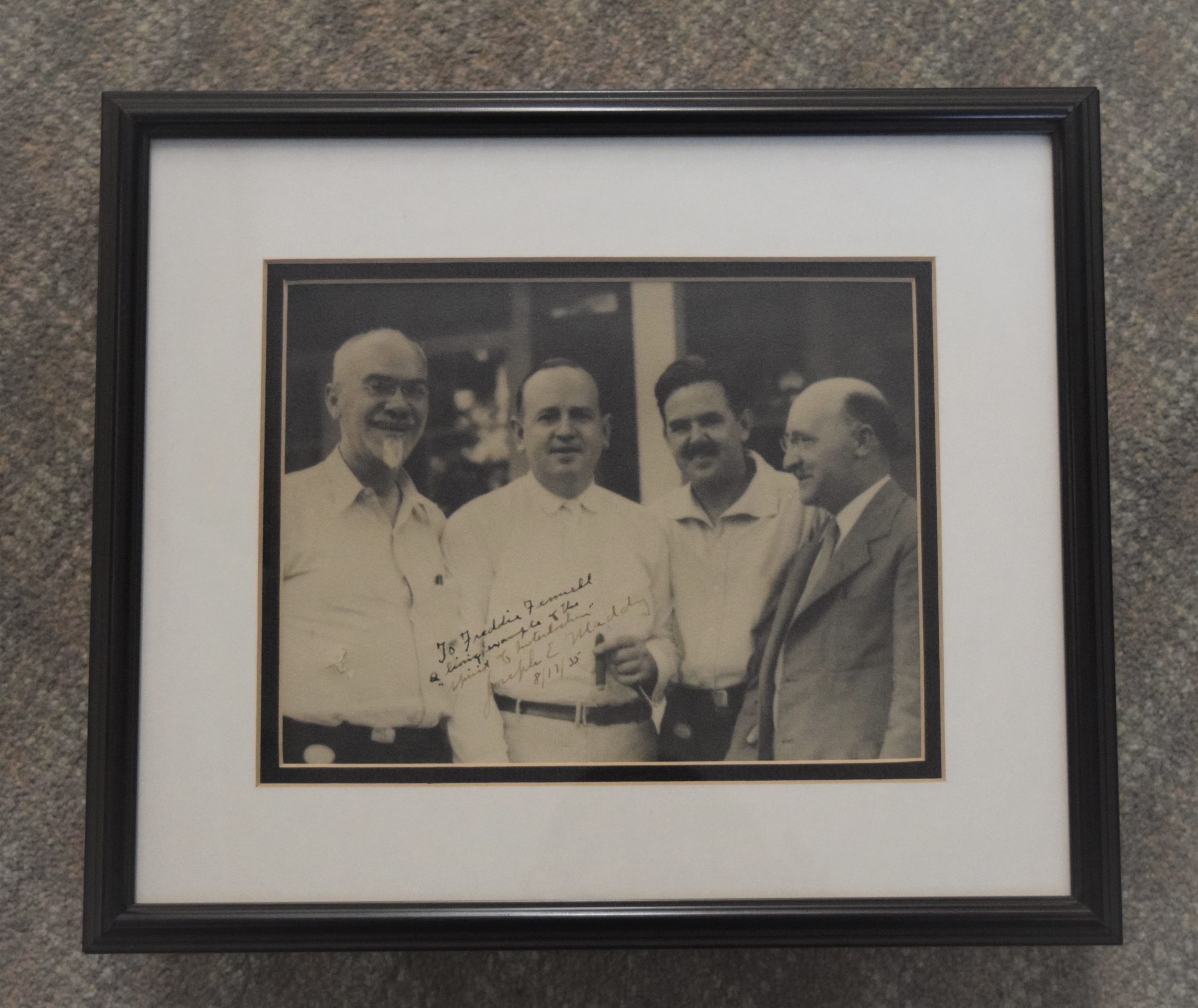
National Music Camp faculty (1935)
National Music Camp founder Joseph E. Maddy (1891-1966) presented this photograph to Fennell in 1935, during the summer between Fennell’s sophomore and junior years at Eastman. Mr. Maddy stands second from the right; at the far left is his National Music Camp co-founder Thaddeus P. Giddings (1869-1954).
During that summer at Interlochen, Fennell was engaged to teach drum majoring and baton twirling. The inscription on the photograph—in which Mr. Maddy called the young Fennell “a living example of the ‘Spirit of Interlochen’”—indicates the high regard in which Fennell’s mentors held him. Fennell was then 21 years old.
University of Rochester Marching Band (1937)
The University of Rochester Marching Band, directed by Frederick Fennell, photographed in the Palestra just before the first game of the 1937 football season. The band members are sporting their newly delivered made-to-measure uniforms after having marched in improvised uniforms each season from 1933 through 1936.
The Marching Band was the direct antecedent of the University of Rochester (and then the Eastman School) Symphony Band. Fennell arrived at Eastman intent on trying out for the drum majorship of the University of Rochester’s marching band, only to learn that no such band existed. He therefore set about founding one; no fewer than 56 men turned out for an initial drill that Fennell was allowed to hold in the Palestra. The new marching band attended every game that fall, and after the season, they held together to play concert music for fun, receiving permission to use rehearsal space at Strong Auditorium. Fennell later secured funding for 1934, and pushed for a formal concert in spring 1935. Under his direction, the new University of Rochester Symphony Band played its debut concert on January 25th, 1935 at Strong Auditorium. Howard Hanson was in attendance and came backstage to invite Fennell to repeat the concert in Kilbourn Hall. Thereafter the Symphony Band played its Kilbourn Hall debut on March 23rd, 1936. In that same academic year the band was added to the ESM curriculum as a credit-earning course.
Fennell’s band activity had significant implications for his career at Eastman and beyond. One day RPO Music Director José Iturbi slipped unobserved into a band rehearsal, and was so impressed by Fennell that during a later RPO rehearsal he asked Fennell, then playing in the orchestra’s percussion section, to take over the direction of the orchestra while he, Iturbi, listened to the orchestra from the house. Inspired by the experience of directing the orchestra, Fennell later described the effect as “overwhelming”.
Fennell at Interlochen (1940)
Fennell captured in several photographs that were taken during the summer of 1940 while he was conductor of the National High School Band at Interlochen. His written comment on the reverse side of the frame is revealing. “Center photo is a favorite, with evidence of my maturity on its way . . . after all those years of the little-boy look.”
Fennell’s connection with the National Music Camp was essentially lifelong, manifest in his continued patronage and pedagogic commitment. After his enrollment as a camper in three summers (1931-33), he returned to Interlochen in one capacity or another—whether conductor, instructor, or guest—in altogether 60 summers between 1935 and 2003.
Fennell’s BM diploma & Performer’s diploma from ESM (1937)
Significantly, Fennell’s B.Mus. degree and his Performer’s Diploma (today called the Performer’s Certificate) were the first to be conferred by the Eastman School for performance on tympani and percussion. In completion of the performance requirements for the Performer’s Diploma, Fennell appeared in one of the 1936-37 academic year’s Graduation Recitals with Orchestra, performing the Concerto for Tympani by Kurt Striegler (1886-1958) with the Rochester Civic Orchestra, conducted by Howard Hanson, on April 9th, 1937. His profile in the 1937 yearbook summarized his many extra-curricular activities, which included, in his senior year, playing in the Rochester Philharmonic Orchestra and also serving as an Instrumental Music Supervisor at Pittsford High School.
Fennell’s MM diploma from ESM (1939)
In the service of his master’s degree at the Eastman School, Fennell completed a thesis, Orchestral Development of the Kettledrum from Purcell through Beethoven. As he would later recount, while studying repertoire for his thesis, “I became a looker as well as a listener. Research to support the thesis meant that I had to explore all printed scores before Purcell and then patiently to peruse every score in the complete works of Purcell, Bach, Handel, Haydn, Mozart, and Beethoven. Through this survey of a composer’s use of the kettledrums I had the chance to observe much beyond that area as well.”
Fennell with Service Little Symphony Orchestra (1944)
During World War II Fennell served the nation in a musical capacity, being appointed one of ten national music advisors to the United Service Organizations (USO). The role of each USO music advisor was to organize and direct musical ensembles in the various branches of the armed forces. Fennell was on leave from the Eastman School for two years (1943-45), during which time he was stationed in San Diego, California. His primary activity was to conduct the Service Little Symphony Orchestra, sponsored by the San Diego USO Council and which he founded, recruiting its members from eight San Diego military and naval installations. Fennell also gave lectures on music to the local community.
This photograph was taken on March 9th, 1944 at Theodore Roosevelt Junior High School (San Diego), on the occasion of the Service Little Symphony’s debut concert. On the program were Mozart’s Overture to Don Giovanni and his Piano Concerto no. 20 in D minor (Max Walmer, soloist); Wagner’s Siegfried Idyll, and Beethoven’s Symphony no. 1.
A Rochester connection proved advantageous for Fennell at the USO when, in the spring of 1944, pianist and RPO Music Director (served 1936-44) José Iturbi offered, out of friendship for Fennell, to appear as soloist with the Service Little Symphony Orchestra. Iturbi, newly arrived in Hollywood to work in Hollywood, was working tirelessly in the war effort, making tours of service to appear at military camps as both pianist and conductor. On May 28th, 1944 he performed the Grieg Piano Concerto under Fennell’s baton in a concert given in aid of Russian War Relief. To gain admission to the concert, audience members donated garments of clothing for distribution to the war needy.
Fennell rehearsing Service Little Symphony Orchestra with José Iturbi (1944)
Fennell rehearsing his Service Little Symphony Orchestra (USO) with piano soloist José Iturbi in San Diego. Together they performed the Grieg Piano Concerto in a concert in aid of Russian War Relief on May 28th, 1944. Several years earlier, the two men had been colleagues in a different capacity, when Fennell had played percussion under Iturbi’s baton in the Rochester Philharmonic during the 1936-37 season.
ESM ensembles perform Berlioz’s Grand Symphony (1948)
Fennell leading what was apparently a performance milestone in the Eastman Theater. In concert on January 14th, 1948, the Eastman School Symphony Band was assisted by the Eastman School Junior Symphony and the Eastman School Chorus in a performance of the Grand Symphony for Band: Funeral and Triumphal, opus 15 by Hector Berlioz, which Berlioz composed for the occasion of the transfer of the remains of the victims of the Revolution of July to the Bastille Column (and therefore performed outdoors). The printed program represented that the Eastman Theater performance was the first in the United States; Fennell’s own annotation, penned on the frame’s reverse side, asserted that the performance marked the work’s first-ever complete performance in the United States with representation of all three forces (band, chorus, orchestra). Note that both the Eastman School Symphony Band and the Eastman School Junior Symphony Orchestra were Fennell’s regular conducting assignments.
Fennell conducting Eastman Chamber Orchestra (1954)
Fennell conducting the Eastman Chamber Orchestra—its members clad in the white attire traditionally reserved for summer—in its debut season, summer 1954. Launched by Fennell himself, the ECO was a summer orchestra comprised of ESM faculty members and students, representing the ESM’s first regularly appearing concert orchestra that was comprised of mixed (student/faculty) personnel. The ECO gave its first public concert on July 1st, 1954. Between 1954 and 1965 the ECO gave an average of five concerts each summer.
Fennell was the ECO’s regular conductor from 1954 through 1962; he was succeeded by A. Clyde Roller in 1963-64, who in turn was succeeded by visiting faculty member Richard Bales in 1965-67. With ensuing changes in personnel and ESM curricular objectives, the ECO’s mission and formation likewise underwent changes, eventually becoming in the 1970s an all-student orchestra that performed during the academic year.
Fennell conducting Eastman Wind Ensemble (1956)
Fennell conducting the Eastman Wind Ensemble in a concert billed as “Ruffles and Flourishes” on May 4th, 1956. The program consisted of music for fife and drums, and for bugles, cymbals, and drums, based on the field music of the United States Army from the Revolutionary War to the then-present day. The program was subdivided into six parts, the music in each part being organized around some given medium or genre.
Two days later the EWE recorded the repertory in the Eastman Theater, to be released on two Mercury albums: The Spirit of ’76, and Ruffles and Flourishes.
Fennell after EWE recording session (1956)
Relevant personnel gather in an Eastman Theater dressing room following the Eastman Wind Ensemble recording session of May 6th, 1956. From left to right are C. Robert (Bob) Fine, Mercury Records recording engineer; Wilma Cozart, VP of Mercury Records’ Classical Division; and Fennell. Wilma Cozart (1927-2009) served as Recording Director for several of Mercury’s EWE recordings; in private life, she was married to Mercury Records engineer Bob Fine (1922-1982). As noted by Fennell on the frame’s reverse side, the photo was taken by William L. Decker, “. . . who drove Bob’s truck” (the mobile recording van).
Fennell with Bob Fine (1953)
“The genius of recorded sound”—so wrote Fennell on the reverse side of the photograph at right, summing up the essence of the Eastman Wind Ensemble’s ground-breaking experience making recordings with Mercury Records, whose “Living Presence” series brought the EWE sound into so many living rooms across the nation. In the photograph, Mercury’s chief engineer and technical supervisor for the EWE recordings, C. Robert (Bob) Fine, appears with Fennell in May, 1953 following the EWE’s first-ever recording session. The two men are in Mercury’s mobile recording van that was parked in the Eastman School garage (formerly at 50 Swan Street) during recording sessions. With the one exception of just one album, the EWE’s 1953-62 recording sessions took place in the Eastman Theater.
The EWE’s fruitful relationship with Mercury Records spanned from May, 1953 until May, 1962, during which time the EWE made 25 separate recordings for Mercury (including one single and one unreleased album). Those recordings represented the most up-to-date recording technology then commercially available. Mercury’s “Living Presence” series was the result of significant technological advances made by the recording industry in the late 1940s. The techniques employed in recording the “Living Presence” stereo long-playing albums made it possible to record and reproduce two separate audio channels within a single groove. By use of a stereo cartridge, the two channels would then be transmitted to two amplifiers and loudspeakers, resulting in a vivid sonic re-creation of a live performance with the full aural depth and spaciousness that were the potential of stereophonic recording.
Fennell receiving honorary doctorate from OCU (1957)
Fennell receiving an honorary doctorate at Oklahoma City University on May 27th, 1957. Similar honors would follow in later years when he would receive honorary doctorates from the University of Rochester (1988), from St. Olaf College (2003), and from the University of Connecticut-Storrs (2003).
Eastman Philharmonia with Howard Hanson and Fennell (1961)
The 87 members of the 1961-62 Eastman Philharmonia pose on-stage in the Eastman Theater with Howard Hanson and Frederick Fennell, the two appointed conductors who would direct their music-making during their three-month State Department-sponsored tour in the winter of 1961-62. Howard Hanson invited Frederick Fennell to accompany him on the tour as Associate Conductor, but it was the perception of many that Hanson slighted Fennell by curtailing the latter’s opportunities to conduct. The travel diary kept by bassoonist Richard Rodean (BA ’62, MA ’64) confirms the infrequency of Fennell’s occasions on the podium. Further of note, Mr. Rodean candidly recounts that on one occasion after a performance in Lvov (today Lviv, in the Ukraine) near the end of the tour, the Philharmonia members gave Fennell an ovation.
Fennell with Eastman Philharmonia in Moscow (1962)
Associate Conductor Fennell shaking hands with Eastman Philharmonia concertmaster Richard Kilmer (BM ’61, MM ’64) at a concert in the Great Hall of Moscow Conservatory in January, 1962. The concert was given during the Eastman Philharmonia’s three-month tour of Europe and the Middle East in the winter of 1961-62; fully one month of the tour was spent on the territory of the USSR. Between November 24th, 1961 and February 25th, 1962, the Philharmonia gave 49 concerts in 34 cities in 16 countries, representing the most extensive performing engagement undertaken by any Eastman School of Music ensemble up to that time.
.
EWE Exclusive and Honorable Society of Ching Ffoom (1962)
Founded by Fennell, the “Exclusive and Honorable Society of Ching-Ffoom” numbered among its membership percussionists and others who had played in the Eastman Wind Ensemble, together with any other individuals on whom Fennell conferred honorary membership. The name came from the percussion effect heard when a cymbal crash (ching) is followed by a bass drum loud beat (ffoom) during the final measures of the Trio section of a march, usually within the last 4-6 bars. The gesture brings an audible sense of finality to the end of a Trio section. The graphic representation of this effect would have resonated deeply with Fennell, a percussionist and tympanist.
Presented to Fennell at the end of his last year at the Eastman School of Music, this award was signed by the members of the EWE of 1961-62, who had earned the distinction of performing at Carnegie Hall in a concert given on November 17th, 1961. Fennell’s annotation penned on the frame’s reverse side indicates that the award was made by Annie Boldt (AnnMarie L. Boldt, now Mrs. AnnMarie L. Miller), BM ’62.
With thanks to Dr. Donald Hunsberger, Conductor Emeritus of the Eastman Wind Ensemble, for his conductorial guidance on the significance of the ching-ffoom gesture.
Fennell directing the MSO (1962)
Fennell directing the Minneapolis Symphony Orchestra and the Inter-Collegiate Male Chorus at Northrop Auditorium (Minneapolis) on March 18th, 1962 in a concert billed as “Program for the Centennial Observance of the Civil War”. The program consisted of Morton Gould’s arrangement of the song “When Johnny Comes Marching Home” by Patrick B. Gilmore; Fennell’s own arrangements of numerous period songs; Aaron Copland’s A Lincoln Portrait; and the premiere performance of Rayburn Wright’s The War for the Union, a symphonic suite for orchestra and men’s chorus based on traditional period music with authentic music of the Union and Confederate armies that Fennell had collected in the course of archival research.
Fully one year earlier Fennell had received the Minneapolis Symphony Orchestra’s invitation to present this concert, coming on the strength of the success of the Eastman Wind Ensemble’s album The Civil War: Its Music and Its Sounds. Two months after this concert Fennell accepted the newly created position of Associate Music Director to serve at Minneapolis alongside Stanislaw Skrowaczewski; he was engaged for a two-year term.
MSO performs Orff’s Carmina Burana (1962)
Fennell appearing with the assembled performing forces on-stage at Northrop Auditorium (Minneapolis) for the first Minneapolis performance of Carl Orff’s Carmina Burana on December 9th, 1962. The Minneapolis Symphony Orchestra was joined in performance by the Macalester College Choir (Johannes Dahle, director) and by soloists Mary Ellen Jenkins, soprano; Walter Cherwin, tenor; and Norman Abelson, bass. It had been Fennell’s own intention to program this work during his first season at Minneapolis. A clue to the ovation accorded the performance may be found in Fennell’s diary entry for December 9th, where he wrote one single word: “Smash!”.
Fennell rehearses MSO with Van Cliburn (1963)
At Northrop Auditorium (Minneapolis) on February 2nd, 1963, Fennell leads a rehearsal of the Minneapolis Symphony Orchestra with piano soloist Van Cliburn, who had been engaged for a special concert in aid of the orchestra members’ pension fund. Mr. Cliburn’s international career was in full swing in those years immediately following his triumph in the first quadrennial Tchaikovsky International Piano Competition (1958). The program for the evening’s concert was appropriately soloist-focussed, offering two warhorses for piano and orchestra separated by an orchestral interlude: the Piano Concerto no. 2 by Brahms; “Alborada del Gracioso” from Miroirs by Ravel (in the composer’s own orchestration); and the Piano Concerto no. 3 by Rachmaninoff.
Letter from Daniel Maxey (1963)
A letter singled out by Fennell for special mention. After one of the Young People’s Concerts by the Minneapolis Symphony Orchestra (a series launched by Fennell), young Daniel Maxey sent him this letter (“Simple wisdom from a young boy,” as Fennell noted). So impressed was Fennell that he sent copies of the letter to all members of the MSO’s Board; no responses were forthcoming.
Fennell Mercury Records poster (1960s)
Promotional poster for Fennell’s recordings on the Mercury label. He conducted not only the Eastman Wind Ensemble for Mercury recordings, but also conducted the Eastman-Rochester Symphony Orchestra in selected “pops” repertory for Mercury release. This poster, and others like it, would have been displayed on cardboard easels in record stores across the nation in the 1960s. The photograph captures Fennell on the podium during the recording sessions for the album Broadway Marches, recorded on May 19th and 20th, 1964 at the C. Robert Fine Studio at the Great Northern Hotel in New York City (named for Mercury engineer C. Robert Fine). The photo was taken by Morrie Lawrence (Mrs. Mary Morris Lawrence), wife of Harold Lawrence, the Music Director of Mercury Records’ Classical Division. Harold Lawrence supervised several of the Mercury recordings conducted by Fennell.
Fennell directing University of Miami Symphony Orchestra (1966)
Fennell directing the University of Miami Symphony Orchestra in concert in the Armory on the campus of the University of Miami (Coral Gables, Florida) on November 5th, 1966. He was then in his second academic year of service at that institution. From 1965 until 1980 Fennell was Conductor-in-Residence, and also served as Professor of Conducting in the University of Miami School of Music. As Conductor-in-Residence he conducted the University’s symphony orchestra and wind ensemble.
Fennell conducting at Combined Invitational Band Clinic in OK (1968)
Numerous images in the Frederick Fennell Collection capture Fennell on the podium in poses of varying degrees of dramatic effect. This sequence of photographs capture him when he was one of two featured clinicians at the Combined Invitational Band Clinic of U.S. Grant High School (Oklahoma City, Oklahoma) and Norman High School (Norman, Oklahoma), which took place in Oklahoma City on January 29th-30th, 1968. Altogether, seven high school bands participated in the clinic. At the evening concert on January 29th, the Southeast High School Band (Oklahoma City, Oklahoma; Jerry Howard, Director) performed two selections, of which one was the Toccata attributed by Gaspar Cassadó to Girolamo Frescobaldi, and arranged by Earl Slocum (the movement is marked Allegro giusto). The clinic’s printed program indicates that Fennell had been the clinician with the Southeast band earlier that day in a rehearsal session, during which the photos were taken.
Alice M. Ditson Conductor’s Award (1969)
On June 3rd, 1969, Columbia University presented Fennell its Alice M. Ditson Conductor’s Award for 1969 in honor of “his services to the American composer in general and his unique contribution to the creation of a repertory of American works for the wind ensemble”.
Fennell at ESM 50th anniversary gala concert (1972)
Ten years after leaving the Eastman School of Music, Fennell was one of four guest conductors taking the stage at a gala concert on April 6th, 1972 that was part of the ESM’s year-long 50th anniversary celebration. That night Fennell directed the Eastman Wind Ensemble in Apotheosis of This Earth by Karel Husa (b. 1921), for which Donald Hunsberger had rehearsed the EWE members. Fennell’s personal reflections on the event, which he wrote on the reverse side of the frame, are particularly revealing. While the concert was formally in observance of the ESM’s 50th anniversary, Fennell privately considered it to be a celebration of the EWE’s 20th anniversary. Far more personal, though, was his next thought: “I felt, after the wonderful performance, that my life has meant something.”
Photograph by Louis Ouzer (1912-2002).
Fennell recording session with Cleveland Symphonic Winds (1978)
Fennell is here seen during yet another historic recording session. At the invitation of Telarc Records, he made a recording with the Cleveland Symphonic Winds that was captured by means of the digital recording process devised by Salt Lake City-based Soundstream, Inc.. The process employed computer technology to ensure high quality and a minimum of extraneous noise. The Telarc recording—called simply The Cleveland Symphonic Winds (Telarc DG 5038; later re-issued on CD), and presenting works by J. S. Bach, Gustav Holst, and G. F. Handel—would represent the first digital recording of classical repertory ever to have been commercially released in the U.S.. The recording sessions took place in Severance Hall (Cleveland) on April 4th-5th, 1978.
The advantages of digital recording were tremendous. Fennell later recounted the exhilaration felt by the assembled listeners during the playback in the listening room, when the recorded result was heard to be “. . . recorded sound of unprecedented depth, clarity, and volume over the widest frequency range — and totally without distortion or the wrong kind of wow. I was hearing it there as I had heard it on the Severance Hall Stage . . . .” (Recounted in Ffortissimo! by Roger Rickson. Ludwig, c1993.) A photograph of Fennell in the recording booth with Dr. Thomas G. Stockham, Jr.—founder of Soundstream, Inc., who provided the on-location digital services to Telarc—was later published in The 1980 World Book Year Book in a summary of noteworthy events of 1978.
Fennell with Donald Hunsberger (1988)
Frederick Fennell and Donald Hunsberger at the Eastman School on October 12th, 1988; Fennell was present for a rehearsal with the Eastman Wind Ensemble. On the following Saturday evening Fennell was guest conductor at the ESM’s annual Prism concert, conducting the EWE in Holst’s Suite No. 1 in E-flat major, and later in the program conducting the Eastman Philharmonia in Respighi’s Fountains of Rome. The concert opened with the conferral of an honorary Doctor of Music degree.
Fennell receives honorary doctorate from ESM (1988)
Fennell receiving an honorary Doctor of Music degree on October 15th, 1988 (exactly 55 years and 33 days after his initial arrival in Rochester on September 12th, 1933, as he wrote on the frame’s reverse side). At left, ESM Director Dr. Robert Freeman reads the citation from the honorary degree as Fennell and UR President Dennis O’Brien listen; at right, President O’Brien confers the degree and congratulates Fennell with a handshake. Immediately after the conferral, Fennell conducted the EWE in the concert’s opening selection.
New Yorker cartoon (1935, framed 1988)
Fennell admired this rendering by renowned New Yorker cartoonist Chas. Addams of a Salvation Army band’s message. In his own words:
“I clipped this page from THE NEW YORKER about October 1935; it is his usual magnificence in idea and execution. I mounted it then on cardboard; it stood on shelves in my Eastman studios, at Lake Minnetonka, Miami and Siesta Key.
“I framed it the day Chas. Addams died 30 September 1988.
Siesta Key. FF”
Fennell Favorites recording with Dallas Wind Symphony (1991)
The photographs above depict Fennell conducting the Dallas Wind Symphony in concert at the Morton H. Meyerson Symphony Center (Dallas) on January 8th, 1991. The concert program—consisting of works borrowed from the repertories of the piano, the organ, and the orchestra—was recorded live for release as Fennell Favorites! on the Reference Recordings label. The photographs seen above were all published as the liner artwork, with the central photo forming the liner’s cover. The programmed selections all represented first recordings in Fennell’s discography. Fennell Favorites! was the Dallas Wind Symphony’s third release on the Reference label, and one of a half-dozen recordings altogether that Fennell made with the DWS, of which Fennell was principal guest conductor. In his characteristically minute chronicling of recording-specific details, Fennell noted the timings of the individual works in his diary entry for that date, the concert altogether clocking in at 72:38.
Sonneck Society Honorary Membership (1992)
On February 8th, 1992, at the 40th anniversary celebration of the Eastman Wind Ensemble, Fennell was presented with the Sonneck Society’s Honorary Member award for 1991. The previous April, at the Society’s annual meeting, President Deane L. Root had announced the award with the following citation:
Frederick Fennell has achieved international renown for his development of the wind ensemble, a concept unique to the United States which has influenced countless bands and band directors in this country and abroad. His pioneering series of recordings by the Eastman Wind Ensemble for Mercury brought about a reconsideration of the wind medium and established performance and literature models for the more than 20,000 wind ensembles that were subsequently established in American schools.
Lobby of Frederick Fennell Hall, Japan (1992)
With the Tokyo Kosei Wind Orchestra: Fennell’s final chapter In his 70th year Fennell was appointed Principal Conductor of the Tokyo Kosei Wind Orchestra; his involvement with the TKWO would extend across the remaining two decades of his life. Writing in his diary on January 14th, 1984, Fennell commented on his first rehearsal as the TKWO’s regular conductor ( “Excellent rehearsal” ). In 1996 he was designated Conductor Laureate, a post he would hold until his death; his laureate appointment was marked by a nine-city tour by the ensemble. Besides conducting their home-based concerts, Fennell led the TKWO on tour and also made numerous recordings with the ensemble. The Tokyo Kosei Wind Orchestra was founded in 1960 as the Tokyo Kosei Symphonic Band; the ensemble gave regular performances in Tokyo from 1962 onwards. In 1973 the ensemble’s name was changed to become the Tokyo Kosei Wind Orchestra to reflect its growing professionalism and also the scale of its professional activities. The the lobby of Frederick Fennell Hall, a state-of-the-art concert hall in Kofu, Japan that was the gift of patron Tokio Kikushima to the city of Kofu. Fennell conducted the Tokyo Kosei Wind Orchestra at the dedication concert on July 17th, 1992, and also addressed the audience in Japanese.
America’s Band in Blue baton (1993)
Framed baton in honor of Fennell’s November 23rd, 1993, appearance with the US Air Force band “America’s Band in Blue”. The accompanying plaque reads: “In thoughtful appreciation for the time you have shared with us. Your warmth and caring feelings will always bring fond remembrances for your ‘Band in Blue’”.
John Philip Sousa portrait (received 1998)
This portrait of John Philip Sousa (1854-1932) was the gift of Mr. Soichiro Takahashi, President of the Japan Sousa Society, presented to Fennell at the Society’s 5th anniversary meeting (Tokyo, November 23rd, 1998). The music of John Philip Sousa figured prominently in Fennell’s work with the Eastman Wind Ensemble and elsewhere. Under Fennell’s direction, the EWE recorded Sousa marches on the albums Marches by Sousa and Others, Marching Along (also the title of Sousa’s autobiography), Hands Across the Sea, Sound Off!, and Sousa on Review. Writing the jacket notes for Sound Off!, Fennell admitted his “anguish” at having to choose a mere selection from among the March King’s “staggering output” (136 completed marches altogether)! Earlier in his life Fennell had performed under Sousa’s baton at Interlochen in 1931, playing percussion in the premiere performance of the march The Northern Pines, which Sousa had composed in honor of Interlochen. It was music of Sousa that Frederick Fennell conducted in what would be his final appearance with the Eastman Wind Ensemble. Appearing as Conductor Emeritus in the Eastman Theater on October 15th, 2004, Fennell conducted three Sousa marches in acknowledgement of the year’s Sousa sesquicentennial: Hands Across the Sea, Riders for the Flag, and The Fairest of the Fair.
Art of Frederick Fennell with Tokyo Kosei Wind Orchestra (1992)
A rendering by a local artist—identified only as Hikoi—of Fennell as he conducted the Tokyo Kosei Wind Orchestra at the dedication concert for Frederick Fennell Hall in Kofu, Japan, on July 17th, 1992. A state-of-the-art concert hall, Frederick Fennell Hall was the gift of patron Tokio Kikushima. (Fennell’s handwritten note on the frame’s reverse side confirms the name of the artist. Coincidentally, “hikoi” is Japanese for “march”!)
EWE four conductors (2002)
One additional photograph that would have been included in the physical exhibit honoring Maestro Fennell, had it been known to have hung in his home, was the now-widely-recognized photograph of the four assembled conductors of the Eastman Wind Ensemble, taken in February, 2002 on the occasion of the Eastman School’s observance of the 50th anniversary of the EWE’s founding. This framed copy was sent to Fennell, but through whatever circumstance at that very late time in Fennell’s life, it remained sealed, and was found in that condition when the Eastman School received his papers and effects. Published in Eastman Notes and elsewhere, the photograph is profoundly significant, for in showing Maestro Fennell together with his EWE successors A. Clyde Roller (BM 1941), Donald Hunsberger (BM ’54, MM ’59, DMA ’63), and Mark Davis Scatterday (DMA ’89), each of whom has made a singular contribution to the mission and legacy of the Eastman Wind Ensemble, the image of the four assembled conductors embodies the continuity and success of what Fennell founded at Eastman: an enduring and innovative ensemble that remains dedicated to music-making at the highest level. Acknowledgement of the photograph provides the most fitting conclusion to this survey of Frederick Fennell’s iconographic life.
Audio Excerpts
Eastman Wind Ensemble: Debut Concert (February 8, 1953). Streaming audio available to UR/ESM community.
Fennell favorites! (January 8, 1991). Available at Sibley. Call number: LP 36,856.
Fennell-ebration: Celebrating Frederick Fennell’s 100th Concert (October 17, 2014). Available at Sibley. Call number: SHDD 1665
For further information, please inquire at the Ruth T. Watanabe Special Collections department.


